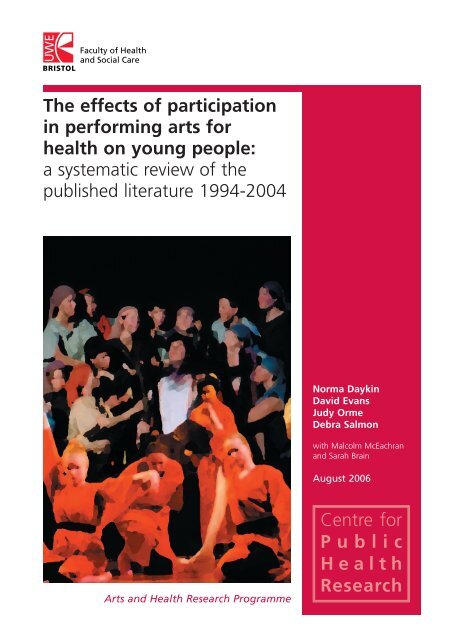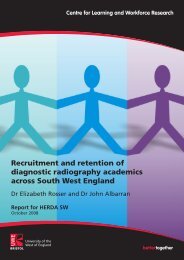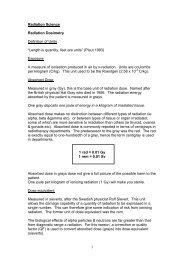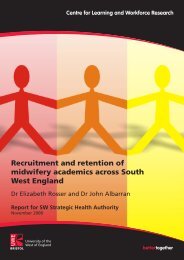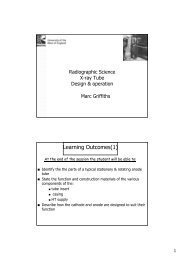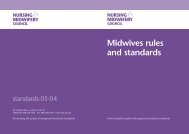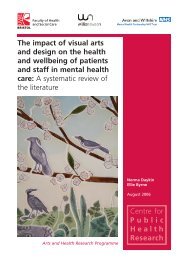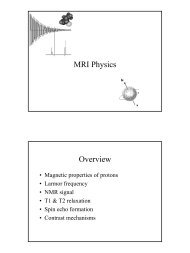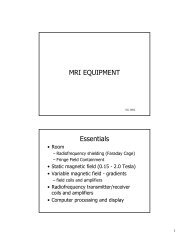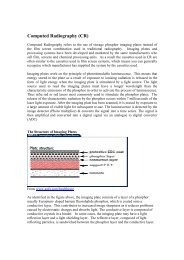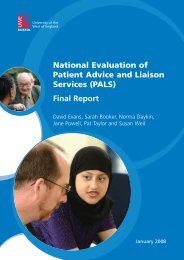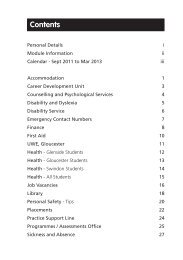The impact of arts on health and wellbeing of young people: a ...
The impact of arts on health and wellbeing of young people: a ...
The impact of arts on health and wellbeing of young people: a ...
You also want an ePaper? Increase the reach of your titles
YUMPU automatically turns print PDFs into web optimized ePapers that Google loves.
<str<strong>on</strong>g>The</str<strong>on</strong>g> effects <str<strong>on</strong>g>of</str<strong>on</strong>g> participati<strong>on</strong><br />
in performing <str<strong>on</strong>g>arts</str<strong>on</strong>g> for<br />
<strong>health</strong> <strong>on</strong> <strong>young</strong> <strong>people</strong>:<br />
a systematic review <str<strong>on</strong>g>of</str<strong>on</strong>g> the<br />
published literature 1994-2004<br />
Norma Daykin<br />
David Evans<br />
Judy Orme<br />
Debra Salm<strong>on</strong><br />
with Malcolm McEachran<br />
<strong>and</strong> Sarah Brain<br />
August 2006<br />
Arts <strong>and</strong> Health Research Programme<br />
Centre for<br />
Public<br />
Health<br />
Research
<str<strong>on</strong>g>The</str<strong>on</strong>g> effects <str<strong>on</strong>g>of</str<strong>on</strong>g> participati<strong>on</strong> in performing <str<strong>on</strong>g>arts</str<strong>on</strong>g> for <strong>health</strong><br />
<strong>on</strong> <strong>young</strong> <strong>people</strong>: A systematic review <str<strong>on</strong>g>of</str<strong>on</strong>g> the published<br />
literature 1994 - 2004<br />
Norma Daykin; David Evans; Judy Orme <strong>and</strong> Debra Salm<strong>on</strong><br />
with Malcolm McEachran <strong>and</strong> Sarah Brain<br />
Acknowledgements<br />
We are grateful to the following <strong>people</strong> for their support in the development <str<strong>on</strong>g>of</str<strong>on</strong>g><br />
this review: Barbara Bigwood for her help with locating the literature; Kathy<br />
Levine <strong>and</strong> the UWE Library staff for their support in h<strong>and</strong>ling the search;<br />
Chris Bridle for his advice <strong>on</strong> systematic review methodology <strong>and</strong> Sim<strong>on</strong><br />
Murphy for his help in the early stages <str<strong>on</strong>g>of</str<strong>on</strong>g> the review. We would also like to<br />
thank Emma Griffin <strong>and</strong> Jane Wathen for their help in preparing the report.<br />
ISBN 1-86043-396-0 <strong>and</strong> 978-1-86043-396-2<br />
Published by the University <str<strong>on</strong>g>of</str<strong>on</strong>g> the West <str<strong>on</strong>g>of</str<strong>on</strong>g> Engl<strong>and</strong>, Bristol<br />
For enquiries about this publicati<strong>on</strong> c<strong>on</strong>tact:<br />
Emma Griffin, Faculty <str<strong>on</strong>g>of</str<strong>on</strong>g> Health <strong>and</strong> Social Care, University <str<strong>on</strong>g>of</str<strong>on</strong>g> the West <str<strong>on</strong>g>of</str<strong>on</strong>g><br />
Engl<strong>and</strong>, Bristol.<br />
Emma2.Griffin@uwe.ac.uk
Table <str<strong>on</strong>g>of</str<strong>on</strong>g> C<strong>on</strong>tents<br />
1. Executive Summary ............................................................................................ 1<br />
2. Background ......................................................................................................... 3<br />
2.1 Arts for <strong>health</strong> activity <strong>and</strong> research: an overview............................................................... 3<br />
2.2 Young <strong>people</strong> <strong>and</strong> <str<strong>on</strong>g>arts</str<strong>on</strong>g> for <strong>health</strong> activity ............................................................................ 3<br />
2.3 Researching <strong>and</strong> evaluating the effects <str<strong>on</strong>g>of</str<strong>on</strong>g> performing <str<strong>on</strong>g>arts</str<strong>on</strong>g> for <strong>health</strong> <strong>on</strong> <strong>young</strong> <strong>people</strong>..... 4<br />
2.4 Rati<strong>on</strong>ale for the literature review........................................................................................ 5<br />
3. Systematic Review Methodology ....................................................................... 7<br />
3.1 <str<strong>on</strong>g>The</str<strong>on</strong>g> search strategy............................................................................................................. 7<br />
3.2 Results................................................................................................................................. 7<br />
3.3 Methodological characteristics <str<strong>on</strong>g>of</str<strong>on</strong>g> the studies...................................................................... 8<br />
4. Results <str<strong>on</strong>g>of</str<strong>on</strong>g> the Quantitative Studies ................................................................. 11<br />
4.1 Peer interacti<strong>on</strong> <strong>and</strong> social skills ....................................................................................... 11<br />
4.2 Knowledge, attitudes <strong>and</strong> risk behaviour in relati<strong>on</strong> to HIV/AIDS ..................................... 12<br />
4.3 Alcohol, tobacco <strong>and</strong> illegal drug use................................................................................ 14<br />
4.4 Sexual <strong>health</strong>..................................................................................................................... 14<br />
4.5 Summary <str<strong>on</strong>g>of</str<strong>on</strong>g> findings from quantitative research ............................................................... 15<br />
5. Results <str<strong>on</strong>g>of</str<strong>on</strong>g> the Qualitative Studies: Key C<strong>on</strong>cepts .......................................... 17<br />
5.1 Pers<strong>on</strong>al benefits: enhancing learning <strong>and</strong> skills .............................................................. 17<br />
5.2 Interacti<strong>on</strong>: enhancing expressi<strong>on</strong> <strong>and</strong> communicati<strong>on</strong> .................................................... 18<br />
5.3 Community benefits: tackling marginalisati<strong>on</strong> <strong>and</strong> representati<strong>on</strong> <str<strong>on</strong>g>of</str<strong>on</strong>g> <strong>young</strong> <strong>people</strong> ......... 18<br />
5.4 <str<strong>on</strong>g>The</str<strong>on</strong>g> importance <str<strong>on</strong>g>of</str<strong>on</strong>g> participati<strong>on</strong> <strong>and</strong> involvement <str<strong>on</strong>g>of</str<strong>on</strong>g> <strong>young</strong> <strong>people</strong>................................... 19<br />
5.5 Risk <strong>and</strong> reluctance ........................................................................................................... 19<br />
5.6 Summary: key findings from qualitative research.............................................................. 20<br />
6. Limitati<strong>on</strong>s <str<strong>on</strong>g>of</str<strong>on</strong>g> the Review ................................................................................. 21<br />
7. C<strong>on</strong>clusi<strong>on</strong>s: A Research Agenda ................................................................... 23<br />
7.1 Issues for quantitative research......................................................................................... 23<br />
i
7.2 Issues for qualitative research........................................................................................... 23<br />
References............................................................................................................. 25<br />
Appendix 1: Databases Searched........................................................................................... 29<br />
Appendix 2: Search Terms Used............................................................................................. 30<br />
Appendix 3: Inclusi<strong>on</strong> <strong>and</strong> Exclusi<strong>on</strong> Criteria Used in the Review .......................................... 31<br />
Appendix 4: Overview <str<strong>on</strong>g>of</str<strong>on</strong>g> Search Strategy <strong>and</strong> Results........................................................... 32<br />
Appendix 5: Overview <str<strong>on</strong>g>of</str<strong>on</strong>g> Quantitative Studies Included in the Review................................... 33<br />
Appendix 6: Overview <str<strong>on</strong>g>of</str<strong>on</strong>g> Qualitative Studies Included in the Review ..................................... 34<br />
Appendix 7: Data Extracti<strong>on</strong> Sheet.......................................................................................... 35<br />
ii
1. Executive Summary<br />
(i)<br />
<str<strong>on</strong>g>The</str<strong>on</strong>g>re is increasing interest in the role <str<strong>on</strong>g>of</str<strong>on</strong>g> <str<strong>on</strong>g>arts</str<strong>on</strong>g> in <strong>health</strong> care, <strong>and</strong> a<br />
growing c<strong>on</strong>sensus that participati<strong>on</strong> in <str<strong>on</strong>g>arts</str<strong>on</strong>g> activities can have a<br />
transformative <str<strong>on</strong>g>impact</str<strong>on</strong>g> up<strong>on</strong> the lives <str<strong>on</strong>g>of</str<strong>on</strong>g> <strong>young</strong> <strong>people</strong>. While there is<br />
growing evidence to support the benefits <str<strong>on</strong>g>of</str<strong>on</strong>g> <str<strong>on</strong>g>arts</str<strong>on</strong>g> for <strong>health</strong> <strong>and</strong> well-being,<br />
this is uneven. Most programmes that seek <strong>health</strong> outcomes through the<br />
performing <str<strong>on</strong>g>arts</str<strong>on</strong>g> have not been subject to high quality evaluati<strong>on</strong>.<br />
(ii)<br />
(iii)<br />
(iv)<br />
(v)<br />
(vi)<br />
This literature review seeks to provide an overview <str<strong>on</strong>g>of</str<strong>on</strong>g> current evidence<br />
surrounding the effects <str<strong>on</strong>g>of</str<strong>on</strong>g> <str<strong>on</strong>g>arts</str<strong>on</strong>g> for <strong>health</strong> <strong>on</strong> adolescents <strong>and</strong> <strong>young</strong><br />
<strong>people</strong> between 11 <strong>and</strong> 18 years old. <str<strong>on</strong>g>The</str<strong>on</strong>g> review includes music,<br />
performance, drama <strong>and</strong> dance in community settings as well as n<strong>on</strong>curricular<br />
activity in mainstream educati<strong>on</strong>. Clinical populati<strong>on</strong>s <strong>and</strong><br />
settings such as hospitals were not included in the review: research in<br />
these settings addresses different questi<strong>on</strong>s <strong>and</strong> uses different<br />
methodologies to that in community settings. <str<strong>on</strong>g>The</str<strong>on</strong>g> review seeks to<br />
strengthen the evidence base surrounding <str<strong>on</strong>g>arts</str<strong>on</strong>g> for <strong>health</strong> activity am<strong>on</strong>g<br />
<strong>young</strong> <strong>people</strong> in the community.<br />
Our literature search identified 3670 papers, 104 <str<strong>on</strong>g>of</str<strong>on</strong>g> which met our<br />
relevance criteria. A total <str<strong>on</strong>g>of</str<strong>on</strong>g> 85 full text papers were scrutinised in the<br />
review, including 30 reports <str<strong>on</strong>g>of</str<strong>on</strong>g> quantitative studies <strong>and</strong> 55 reports <str<strong>on</strong>g>of</str<strong>on</strong>g><br />
qualitative <strong>and</strong> mixed methods research. Many <str<strong>on</strong>g>of</str<strong>on</strong>g> these were excluded<br />
<strong>on</strong> the grounds that they were not reporting <strong>on</strong> an interventi<strong>on</strong> or, in the<br />
case <str<strong>on</strong>g>of</str<strong>on</strong>g> qualitative accounts, were reportage rather than research. A<br />
total <str<strong>on</strong>g>of</str<strong>on</strong>g> 15 papers are included in the review: 9 <str<strong>on</strong>g>of</str<strong>on</strong>g> these were reports <str<strong>on</strong>g>of</str<strong>on</strong>g><br />
quantitative research <strong>and</strong> 6 qualitative research papers. All <str<strong>on</strong>g>of</str<strong>on</strong>g> these<br />
projects focused <strong>on</strong> drama interventi<strong>on</strong>s: hence our research found no<br />
evidence <str<strong>on</strong>g>of</str<strong>on</strong>g> evaluated music <strong>and</strong> dance interventi<strong>on</strong>s within n<strong>on</strong>-clinical<br />
settings.<br />
Our review included critical appraisal <str<strong>on</strong>g>of</str<strong>on</strong>g> studies <strong>and</strong> a number <str<strong>on</strong>g>of</str<strong>on</strong>g> validity<br />
issues were identified. In relati<strong>on</strong> to quantitative research, we found<br />
some good examples <str<strong>on</strong>g>of</str<strong>on</strong>g> c<strong>on</strong>trolled studies that used r<strong>and</strong>omisati<strong>on</strong> to<br />
allocate individuals to interventi<strong>on</strong> or c<strong>on</strong>trol groups, although the<br />
majority <str<strong>on</strong>g>of</str<strong>on</strong>g> studies used n<strong>on</strong>-r<strong>and</strong>om samples. Issues <str<strong>on</strong>g>of</str<strong>on</strong>g> sample size,<br />
power c<strong>on</strong>siderati<strong>on</strong>s, r<strong>and</strong>omisati<strong>on</strong> <strong>and</strong> blinding need to be addressed<br />
in future research.<br />
In relati<strong>on</strong> to qualitative research, we found that methodologies <str<strong>on</strong>g>of</str<strong>on</strong>g> acti<strong>on</strong><br />
research, grounded theory <strong>and</strong> ethnography were used to good effect.<br />
However, issues <str<strong>on</strong>g>of</str<strong>on</strong>g> reporting <str<strong>on</strong>g>of</str<strong>on</strong>g> data collecti<strong>on</strong>, appropriate frameworks<br />
<str<strong>on</strong>g>of</str<strong>on</strong>g> data analysis, ethical issues <strong>and</strong> c<strong>on</strong>siderati<strong>on</strong> <str<strong>on</strong>g>of</str<strong>on</strong>g> the relati<strong>on</strong>ships<br />
between researcher <strong>and</strong> participants need to be addressed in future<br />
research.<br />
<str<strong>on</strong>g>The</str<strong>on</strong>g> issue <str<strong>on</strong>g>of</str<strong>on</strong>g> heterogeneity is str<strong>on</strong>gly apparent in both the quantitative<br />
<strong>and</strong> qualitative studies, which reported <strong>on</strong> diverse populati<strong>on</strong>s,<br />
interventi<strong>on</strong>s <strong>and</strong> settings, making any kind <str<strong>on</strong>g>of</str<strong>on</strong>g> synthesis <str<strong>on</strong>g>of</str<strong>on</strong>g> the results<br />
1
inappropriate. Instead, we present a thematic overview <str<strong>on</strong>g>of</str<strong>on</strong>g> the results <str<strong>on</strong>g>of</str<strong>on</strong>g><br />
both groups <str<strong>on</strong>g>of</str<strong>on</strong>g> studies.<br />
(vii)<br />
(viii)<br />
(ix)<br />
(x)<br />
<str<strong>on</strong>g>The</str<strong>on</strong>g> quantitative studies reported outcomes in three main areas: peer<br />
interacti<strong>on</strong> <strong>and</strong> social skills; HIV/AIDS; sexual <strong>health</strong>, <strong>and</strong> alcohol,<br />
tobacco <strong>and</strong> drug use. Positive benefits <str<strong>on</strong>g>of</str<strong>on</strong>g> <str<strong>on</strong>g>arts</str<strong>on</strong>g> reported included<br />
changes in attitude, knowledge <strong>and</strong> reported behaviour in all <str<strong>on</strong>g>of</str<strong>on</strong>g> these<br />
areas although the research was not always c<strong>on</strong>sistent. <str<strong>on</strong>g>The</str<strong>on</strong>g> studies use<br />
a variety <str<strong>on</strong>g>of</str<strong>on</strong>g> validated measures <str<strong>on</strong>g>of</str<strong>on</strong>g> attitudes <strong>and</strong> knowledge. While these<br />
measures provide useful indicators it is important not to c<strong>on</strong>flate attitudes<br />
<strong>and</strong> knowledge with behaviour when interpreting the results <str<strong>on</strong>g>of</str<strong>on</strong>g> studies.<br />
Positive <str<strong>on</strong>g>impact</str<strong>on</strong>g>s <str<strong>on</strong>g>of</str<strong>on</strong>g> performing <str<strong>on</strong>g>arts</str<strong>on</strong>g> were also reported from qualitative<br />
research. A number <str<strong>on</strong>g>of</str<strong>on</strong>g> key c<strong>on</strong>cepts emerged from the studies relating<br />
to pers<strong>on</strong>al benefits, enhanced interacti<strong>on</strong> <strong>and</strong> communicati<strong>on</strong>, <strong>and</strong><br />
community empowerment. Process issues were also examined in the<br />
qualitative research, <strong>and</strong> greater underst<strong>and</strong>ing is needed <str<strong>on</strong>g>of</str<strong>on</strong>g> the<br />
influence <str<strong>on</strong>g>of</str<strong>on</strong>g> staff, teachers, peers <strong>and</strong> group leaders <strong>on</strong> the success or<br />
failure <str<strong>on</strong>g>of</str<strong>on</strong>g> performing <str<strong>on</strong>g>arts</str<strong>on</strong>g> initiatives. <str<strong>on</strong>g>The</str<strong>on</strong>g> importance <str<strong>on</strong>g>of</str<strong>on</strong>g> involvement <strong>and</strong><br />
participati<strong>on</strong> <str<strong>on</strong>g>of</str<strong>on</strong>g> <strong>young</strong> <strong>people</strong> in the research is a key issue emphasised<br />
in several qualitative studies.<br />
Most <str<strong>on</strong>g>of</str<strong>on</strong>g> the studies focus <strong>on</strong> positive effects <str<strong>on</strong>g>of</str<strong>on</strong>g> <str<strong>on</strong>g>arts</str<strong>on</strong>g> <strong>and</strong> few focus <strong>on</strong><br />
risks or negative aspects. Negative aspects <strong>and</strong> risks <str<strong>on</strong>g>of</str<strong>on</strong>g> drama were<br />
discussed in <strong>on</strong>e qualitative study, which suggested that there is a need<br />
to further underst<strong>and</strong> the reas<strong>on</strong>s why some <strong>young</strong> <strong>people</strong> might be<br />
reluctant to participate in initiatives like drama.<br />
<str<strong>on</strong>g>The</str<strong>on</strong>g> review dem<strong>on</strong>strates that research <strong>on</strong> the <str<strong>on</strong>g>impact</str<strong>on</strong>g> <str<strong>on</strong>g>of</str<strong>on</strong>g> performing <str<strong>on</strong>g>arts</str<strong>on</strong>g><br />
<strong>on</strong> the <strong>health</strong> <str<strong>on</strong>g>of</str<strong>on</strong>g> <strong>young</strong> <strong>people</strong> is at an early stage. A number <str<strong>on</strong>g>of</str<strong>on</strong>g> priorities<br />
for future research are identified including:<br />
<br />
<br />
<br />
<br />
A need for further quantitative <strong>and</strong> qualitative research <strong>on</strong><br />
performing <str<strong>on</strong>g>arts</str<strong>on</strong>g> other than drama outside <str<strong>on</strong>g>of</str<strong>on</strong>g> clinical settings.<br />
A need for greater rigour in the selecti<strong>on</strong>, applicati<strong>on</strong> <strong>and</strong> reporting<br />
<str<strong>on</strong>g>of</str<strong>on</strong>g> qualitative research procedures, particularly data analysis.<br />
Problems <str<strong>on</strong>g>of</str<strong>on</strong>g> bias can be reduced by use <str<strong>on</strong>g>of</str<strong>on</strong>g> independent<br />
researchers. Where this is not possible, rigorous models <str<strong>on</strong>g>of</str<strong>on</strong>g><br />
practiti<strong>on</strong>er research are needed in order to move bey<strong>on</strong>d the<br />
comm<strong>on</strong> practice <str<strong>on</strong>g>of</str<strong>on</strong>g> journalistic reporting by those resp<strong>on</strong>sible for<br />
both the interventi<strong>on</strong> <strong>and</strong> its evaluati<strong>on</strong>.<br />
Qualitative research needs to draw <strong>on</strong> appropriate models <strong>and</strong><br />
frameworks rather than borrowing language that is more<br />
appropriate to quantitative research.<br />
2
2. Background<br />
2.1 Arts for <strong>health</strong> activity <strong>and</strong> research: an overview<br />
<str<strong>on</strong>g>The</str<strong>on</strong>g>re is increasing interest in the role <str<strong>on</strong>g>of</str<strong>on</strong>g> <str<strong>on</strong>g>arts</str<strong>on</strong>g> in <strong>health</strong> care, a broad field that<br />
encompasses a wide range <str<strong>on</strong>g>of</str<strong>on</strong>g> activities including <str<strong>on</strong>g>arts</str<strong>on</strong>g> therapies, music,<br />
performance, drama <strong>and</strong> dance as well as visual <str<strong>on</strong>g>arts</str<strong>on</strong>g>, poetry <strong>and</strong> creative<br />
writing. Within the UK there are a growing number <str<strong>on</strong>g>of</str<strong>on</strong>g> agencies involved in<br />
sp<strong>on</strong>soring <str<strong>on</strong>g>arts</str<strong>on</strong>g> <strong>and</strong> <strong>health</strong> initiatives. <str<strong>on</strong>g>The</str<strong>on</strong>g>se include Government<br />
departments, such as the Department <str<strong>on</strong>g>of</str<strong>on</strong>g> Culture, Media <strong>and</strong> Sport (DCMS,<br />
1999) <strong>and</strong> the Department <str<strong>on</strong>g>of</str<strong>on</strong>g> Health (DH, 2006), as well as Arts Council<br />
Engl<strong>and</strong> (ACE) <strong>and</strong> its regi<strong>on</strong>al bodies (ACE, 2004; 2006).<br />
<str<strong>on</strong>g>The</str<strong>on</strong>g>se bodies have all called for a strengthening <str<strong>on</strong>g>of</str<strong>on</strong>g> the evidence base for <str<strong>on</strong>g>arts</str<strong>on</strong>g><br />
<strong>and</strong> <strong>health</strong> initiatives. Recent reviews <str<strong>on</strong>g>of</str<strong>on</strong>g> the literature have suggested that<br />
there is growing evidence for the <str<strong>on</strong>g>impact</str<strong>on</strong>g> <str<strong>on</strong>g>of</str<strong>on</strong>g> <str<strong>on</strong>g>arts</str<strong>on</strong>g> <strong>on</strong> <strong>health</strong>, but that this is not<br />
evenly spread across the <strong>health</strong> sector (Staric<str<strong>on</strong>g>of</str<strong>on</strong>g>f, 2004; White <strong>and</strong> Angus,<br />
2003; Angus, 2002). <str<strong>on</strong>g>The</str<strong>on</strong>g> most extensively researched area is music,<br />
particularly music therapy in clinical settings (Staric<str<strong>on</strong>g>of</str<strong>on</strong>g>f, 2004). However, many<br />
<str<strong>on</strong>g>arts</str<strong>on</strong>g> for <strong>health</strong> initiatives are driven not by clinical goals but by social <strong>and</strong><br />
holistic models <str<strong>on</strong>g>of</str<strong>on</strong>g> <strong>health</strong> (Angus, 2002). <str<strong>on</strong>g>The</str<strong>on</strong>g>re is a growing c<strong>on</strong>cern to<br />
develop appropriate evaluati<strong>on</strong> tools for this work that reflect these wider<br />
goals <strong>and</strong> c<strong>on</strong>cepts. <str<strong>on</strong>g>The</str<strong>on</strong>g>re is also a c<strong>on</strong>cern to broaden the focus <str<strong>on</strong>g>of</str<strong>on</strong>g> <str<strong>on</strong>g>arts</str<strong>on</strong>g> <strong>and</strong><br />
<strong>health</strong> work to address key c<strong>on</strong>cerns <str<strong>on</strong>g>of</str<strong>on</strong>g> public <strong>health</strong> such as cor<strong>on</strong>ary heart<br />
disease, obesity <strong>and</strong> sexual <strong>health</strong> (ACE, 2006).<br />
2.2 Young <strong>people</strong> <strong>and</strong> <str<strong>on</strong>g>arts</str<strong>on</strong>g> for <strong>health</strong> activity<br />
As well as focusing largely <strong>on</strong> clinical settings, the current literature tends to<br />
focus <strong>on</strong> adult <strong>health</strong>, with relatively little research <strong>and</strong> evaluati<strong>on</strong> <str<strong>on</strong>g>of</str<strong>on</strong>g> projects<br />
aimed specifically at <strong>young</strong> <strong>people</strong>. Nevertheless, there has within the UK<br />
been increasing investment in <str<strong>on</strong>g>arts</str<strong>on</strong>g> activity by government <strong>and</strong> other agencies.<br />
This is based <strong>on</strong> a growing belief that <strong>young</strong> <strong>people</strong>’s engagement with the<br />
<str<strong>on</strong>g>arts</str<strong>on</strong>g>, irrespective <str<strong>on</strong>g>of</str<strong>on</strong>g> setting, can help even the most vulnerable <strong>young</strong> <strong>people</strong><br />
to develop social <strong>and</strong> life skills (ACE, 2003a; Lloyd <strong>and</strong> Lyth, 2003). <str<strong>on</strong>g>The</str<strong>on</strong>g> Arts<br />
Council claims that engagement <strong>and</strong> participati<strong>on</strong> in <str<strong>on</strong>g>arts</str<strong>on</strong>g> activities can have a<br />
transformative <str<strong>on</strong>g>impact</str<strong>on</strong>g> up<strong>on</strong> the lives <str<strong>on</strong>g>of</str<strong>on</strong>g> <strong>young</strong> <strong>people</strong> (ACE, 2003a; ACE,<br />
2003b). Arts subjects are seen as attracting <strong>young</strong> <strong>people</strong>’s interest because<br />
<str<strong>on</strong>g>of</str<strong>on</strong>g> the alternative, pers<strong>on</strong>al <strong>and</strong> self-fulfilment needs they address (ACE,<br />
2003a).<br />
This is borne out by a nati<strong>on</strong>al study <str<strong>on</strong>g>of</str<strong>on</strong>g> the attitudes <str<strong>on</strong>g>of</str<strong>on</strong>g> <strong>young</strong> <strong>people</strong> to<br />
participati<strong>on</strong> in curriculum-based <str<strong>on</strong>g>arts</str<strong>on</strong>g> subjects (Harl<strong>and</strong> et al., 2000). This<br />
highlighted the sense <str<strong>on</strong>g>of</str<strong>on</strong>g> excitement, fulfilment <strong>and</strong> fun generated by these<br />
subjects, which were reported to provide <strong>young</strong> <strong>people</strong> with opportunities to<br />
relieve stress, deal with criticism <strong>and</strong> explore emoti<strong>on</strong>s. Similarly, findings<br />
from the nati<strong>on</strong>al evaluati<strong>on</strong> ‘Positive Futures’ revealed that <strong>young</strong> <strong>people</strong><br />
reported that their engagement with the performing <str<strong>on</strong>g>arts</str<strong>on</strong>g> also <str<strong>on</strong>g>impact</str<strong>on</strong>g>ed <strong>on</strong> a<br />
wide range <str<strong>on</strong>g>of</str<strong>on</strong>g> outcomes such as relieving stress, calming down, dealing with<br />
3
criticism <strong>and</strong> managing their own emoti<strong>on</strong>s (Positive Futures, 2005; Harl<strong>and</strong><br />
et al., 2000). A nati<strong>on</strong>al evaluati<strong>on</strong> <str<strong>on</strong>g>of</str<strong>on</strong>g> voluntary <str<strong>on</strong>g>arts</str<strong>on</strong>g> projects (Jacks<strong>on</strong>, 2003)<br />
c<strong>on</strong>cluded that the voluntary <str<strong>on</strong>g>arts</str<strong>on</strong>g> present a cost-effective opportunity to<br />
promote government policies with regard to social exclusi<strong>on</strong> <strong>and</strong> life-l<strong>on</strong>g<br />
learning. <str<strong>on</strong>g>The</str<strong>on</strong>g> study suggested that <str<strong>on</strong>g>arts</str<strong>on</strong>g> have therapeutic benefits: they<br />
enable participants to distance themselves from pers<strong>on</strong>al problems <strong>and</strong><br />
provide a way <str<strong>on</strong>g>of</str<strong>on</strong>g> living with ambivalence. Additi<strong>on</strong>ally, <str<strong>on</strong>g>arts</str<strong>on</strong>g> initiatives can be<br />
highly inclusive, motivati<strong>on</strong>al <strong>and</strong> respectful <str<strong>on</strong>g>of</str<strong>on</strong>g> differences. One project leader<br />
claimed that it enabled <strong>people</strong> to ‘transfer their addicti<strong>on</strong> to alcohol <strong>and</strong> drugs<br />
into an addicti<strong>on</strong> to embroidery’ (Jacks<strong>on</strong>, 2003: 6). Drama <strong>and</strong> related <str<strong>on</strong>g>arts</str<strong>on</strong>g><br />
activities seem particularly appealing to girls (Colley <strong>and</strong> Comber, 2003; Miller<br />
<strong>and</strong> Budd, 1999) although a recent study suggests that as well as influencing<br />
factors such as attainment, attendance <strong>and</strong> behaviour, out-<str<strong>on</strong>g>of</str<strong>on</strong>g>-school activities<br />
have an integrative effect for the whole school community (Wilkin et al., 2003).<br />
Since the late 1990s the government has encouraged schools to develop<br />
coherent programmes <str<strong>on</strong>g>of</str<strong>on</strong>g> out-<str<strong>on</strong>g>of</str<strong>on</strong>g>-school activities, supporting the view that by<br />
enhancing emoti<strong>on</strong>al literacy, self-awareness <strong>and</strong> ability to enjoy positive<br />
relati<strong>on</strong>ships with others, these programmes can encourage <strong>young</strong> <strong>people</strong> to<br />
be better able to think, learn <strong>and</strong> make lifestyle decisi<strong>on</strong>s that will promote<br />
their well-being (DfES, 2003). According to MORI <strong>and</strong> BRMB surveys<br />
(Kirkham <strong>and</strong> Evans, 2000), 97% <str<strong>on</strong>g>of</str<strong>on</strong>g> sec<strong>on</strong>dary schools provided out-<str<strong>on</strong>g>of</str<strong>on</strong>g>-school<br />
hours activities. Universally this was at the end <str<strong>on</strong>g>of</str<strong>on</strong>g> the day but they also<br />
provided activities at other times including lunch times (90%), before school<br />
st<str<strong>on</strong>g>arts</str<strong>on</strong>g> (37%), at weekends (60%) <strong>and</strong> during summer holidays (65%). Nearly<br />
all UK sec<strong>on</strong>dary schools <str<strong>on</strong>g>of</str<strong>on</strong>g>fer sports, music <strong>and</strong> creative <strong>and</strong> performing <str<strong>on</strong>g>arts</str<strong>on</strong>g><br />
activities out-<str<strong>on</strong>g>of</str<strong>on</strong>g>-school hours. Almost 70% <str<strong>on</strong>g>of</str<strong>on</strong>g> schools reported that they had<br />
increased their provisi<strong>on</strong> <str<strong>on</strong>g>of</str<strong>on</strong>g> activities in the last two years.<br />
2.3 Researching <strong>and</strong> evaluating the effects <str<strong>on</strong>g>of</str<strong>on</strong>g> performing <str<strong>on</strong>g>arts</str<strong>on</strong>g> for <strong>health</strong><br />
<strong>on</strong> <strong>young</strong> <strong>people</strong><br />
Most programmes that seek <strong>health</strong> promoti<strong>on</strong> outcomes through the<br />
performing <str<strong>on</strong>g>arts</str<strong>on</strong>g> have not been subject to high quality evaluati<strong>on</strong> (Orme <strong>and</strong><br />
Salm<strong>on</strong>, 2002). Further, those programmes that have been evaluated are<br />
rarely comparable, with differences in terms <str<strong>on</strong>g>of</str<strong>on</strong>g> setting, durati<strong>on</strong>, target age<br />
group, peer involvement <strong>and</strong> specificity <str<strong>on</strong>g>of</str<strong>on</strong>g> <strong>health</strong> promoti<strong>on</strong> aims (Angus,<br />
2002). Evaluati<strong>on</strong> is made difficult by a lack <str<strong>on</strong>g>of</str<strong>on</strong>g> clarity about the aims <str<strong>on</strong>g>of</str<strong>on</strong>g><br />
projects. For example, much <str<strong>on</strong>g>arts</str<strong>on</strong>g> for <strong>health</strong> work with <strong>young</strong> <strong>people</strong> has<br />
focused <strong>on</strong> encouraging <strong>young</strong> <strong>people</strong> to resist drugs (Drugs Strategy<br />
Directorate, 2002; Starkey <strong>and</strong> Orme, 2001). Yet a recent review <str<strong>on</strong>g>of</str<strong>on</strong>g> this work<br />
suggests that the aims <str<strong>on</strong>g>of</str<strong>on</strong>g> projects are <str<strong>on</strong>g>of</str<strong>on</strong>g>ten unclear, with <strong>health</strong> related aims<br />
<str<strong>on</strong>g>of</str<strong>on</strong>g>ten added as an afterthought (Davis <strong>and</strong> Daws<strong>on</strong>, 1999). Angus’s review<br />
(2002) <str<strong>on</strong>g>of</str<strong>on</strong>g> <str<strong>on</strong>g>arts</str<strong>on</strong>g> for <strong>health</strong> evaluati<strong>on</strong>s across the UK found that relatively few <str<strong>on</strong>g>of</str<strong>on</strong>g><br />
these stated explicit <strong>health</strong> promoti<strong>on</strong> objectives. Moreover, even fewer<br />
projects explicitly theorise the associati<strong>on</strong> between creative artistic<br />
endeavours <strong>and</strong> <strong>health</strong> promoti<strong>on</strong>.<br />
4
As well as lack <str<strong>on</strong>g>of</str<strong>on</strong>g> clarity about aims, there is a lack <str<strong>on</strong>g>of</str<strong>on</strong>g> agreement about the<br />
best way to evaluate <str<strong>on</strong>g>arts</str<strong>on</strong>g> for <strong>health</strong> projects. Measurable outcomes, such as<br />
psychosocial state, are seen by some as a useful indicator <str<strong>on</strong>g>of</str<strong>on</strong>g> <strong>young</strong> <strong>people</strong>’s<br />
<strong>health</strong> <strong>and</strong> well-being (Murphy <strong>and</strong> Bennett, 2003). Yet methodologies used<br />
within evidence based <strong>health</strong> care, such as the r<strong>and</strong>omised c<strong>on</strong>trol trial (RCT)<br />
are not necessarily accepted as the ‘gold st<strong>and</strong>ard’, with some practiti<strong>on</strong>ers<br />
viewing these approaches as reducti<strong>on</strong>ist <strong>and</strong> likely to undermine the<br />
creativity that defines <str<strong>on</strong>g>arts</str<strong>on</strong>g> interventi<strong>on</strong>s (Angus, 2002). Hence practiti<strong>on</strong>ers<br />
resist crudely causal accounts <str<strong>on</strong>g>of</str<strong>on</strong>g> the relati<strong>on</strong>ship between creative acti<strong>on</strong> <strong>and</strong><br />
<strong>health</strong> outcomes (Health Educati<strong>on</strong> Authority, 1999).<br />
In reality, most <str<strong>on</strong>g>arts</str<strong>on</strong>g> for <strong>health</strong> evaluati<strong>on</strong>s are small scale <strong>and</strong> qualitative in<br />
design. A number <str<strong>on</strong>g>of</str<strong>on</strong>g> <str<strong>on</strong>g>The</str<strong>on</strong>g>atre in Educati<strong>on</strong> (TIE) programmes have been<br />
subject to small scale evaluati<strong>on</strong>s in the past decade. TIE has been<br />
evaluated in c<strong>on</strong>necti<strong>on</strong> with a wide variety <str<strong>on</strong>g>of</str<strong>on</strong>g> issues including sexual <strong>health</strong><br />
(Denman et al., 1995), appropriate physical c<strong>on</strong>tact (Orme <strong>and</strong> Salm<strong>on</strong>, 2002)<br />
<strong>and</strong> homelessness (Day, 2002). Allott et al.’s review (1999) identified a<br />
number <str<strong>on</strong>g>of</str<strong>on</strong>g> evaluati<strong>on</strong>s <str<strong>on</strong>g>of</str<strong>on</strong>g> TIE programmes with drugs educati<strong>on</strong> elements.<br />
TIE programmes tend not to be didactic <strong>and</strong> have an emphasis up<strong>on</strong> affective<br />
<str<strong>on</strong>g>impact</str<strong>on</strong>g> <strong>and</strong> social skills, making quantitative evaluati<strong>on</strong> difficult. Process <strong>and</strong><br />
<str<strong>on</strong>g>impact</str<strong>on</strong>g> evaluati<strong>on</strong>s report positive short-term effects up<strong>on</strong> student attitudes<br />
<strong>and</strong>, to a lesser extent, knowledge. However the review found little evaluati<strong>on</strong><br />
evidence in terms <str<strong>on</strong>g>of</str<strong>on</strong>g> outcome effects.<br />
2.4 Rati<strong>on</strong>ale for the literature review<br />
This literature review seeks to provide an overview <str<strong>on</strong>g>of</str<strong>on</strong>g> current evidence<br />
surrounding the effects <str<strong>on</strong>g>of</str<strong>on</strong>g> <str<strong>on</strong>g>arts</str<strong>on</strong>g> for <strong>health</strong> <strong>on</strong> adolescents <strong>and</strong> <strong>young</strong> <strong>people</strong><br />
between 11 <strong>and</strong> 18 years old. <str<strong>on</strong>g>The</str<strong>on</strong>g> review includes music, performance,<br />
drama <strong>and</strong> dance in community settings as well as n<strong>on</strong>-curricular activity in<br />
mainstream educati<strong>on</strong>. Clinical populati<strong>on</strong>s <strong>and</strong> settings such as hospitals<br />
were not included in the review as research in these settings addresses<br />
different questi<strong>on</strong>s <strong>and</strong> uses different methodologies to that in community<br />
settings. <str<strong>on</strong>g>The</str<strong>on</strong>g> review seeks to strengthen the evidence base surrounding <str<strong>on</strong>g>arts</str<strong>on</strong>g><br />
for <strong>health</strong> activity am<strong>on</strong>g <strong>young</strong> <strong>people</strong> in the community.<br />
5
3. Systematic Review Methodology<br />
3.1 <str<strong>on</strong>g>The</str<strong>on</strong>g> search strategy<br />
<str<strong>on</strong>g>The</str<strong>on</strong>g> literature search was undertaken in July 2004 using the databases<br />
identified in Appendix 1. We restricted the search to publicati<strong>on</strong>s with English<br />
language abstracts published over the last 10 years. Our search terms (see<br />
Appendix 2) reflected our inclusi<strong>on</strong> criteria. We also identified informati<strong>on</strong><br />
produced by key agencies through searching <strong>on</strong> the internet, using broad<br />
search terms including: <strong>young</strong> <strong>people</strong>, performing <str<strong>on</strong>g>arts</str<strong>on</strong>g> <strong>and</strong> research.<br />
Inclusi<strong>on</strong> criteria (see Appendix 3) encompassed populati<strong>on</strong> characteristics,<br />
type <str<strong>on</strong>g>of</str<strong>on</strong>g> interventi<strong>on</strong> <strong>and</strong> research <strong>and</strong> evaluati<strong>on</strong> methods. Hence we<br />
included papers <strong>on</strong> performing <str<strong>on</strong>g>arts</str<strong>on</strong>g> interventi<strong>on</strong>s with children <strong>and</strong> <strong>young</strong><br />
<strong>people</strong> including school pupils between the ages <str<strong>on</strong>g>of</str<strong>on</strong>g> 11 to 18 within<br />
mainstream educati<strong>on</strong> <strong>and</strong> community settings. We excluded research <strong>on</strong><br />
clinical <strong>and</strong> ‘special’ populati<strong>on</strong>s <strong>and</strong> settings such as hospitals, special<br />
schools <strong>and</strong> pris<strong>on</strong>s. In relati<strong>on</strong> to interventi<strong>on</strong>s, we included studies <str<strong>on</strong>g>of</str<strong>on</strong>g><br />
performing <str<strong>on</strong>g>arts</str<strong>on</strong>g> outside <str<strong>on</strong>g>of</str<strong>on</strong>g> the st<strong>and</strong>ard curriculum in three areas: drama,<br />
dance <strong>and</strong> music. We excluded interventi<strong>on</strong>s that took place as part <str<strong>on</strong>g>of</str<strong>on</strong>g> the<br />
regular curriculum as well as other art forms such as visual <str<strong>on</strong>g>arts</str<strong>on</strong>g> <strong>and</strong> martial<br />
<str<strong>on</strong>g>arts</str<strong>on</strong>g>. Where there was any doubt about whether a paper met the inclusi<strong>on</strong><br />
criteria two reviewers screened the full text paper.<br />
3.2 Results<br />
<str<strong>on</strong>g>The</str<strong>on</strong>g> search was undertaken in two phases. <str<strong>on</strong>g>The</str<strong>on</strong>g> phase <strong>on</strong>e database search<br />
resulted in 3670 initial hits (see Appendix 1). <str<strong>on</strong>g>The</str<strong>on</strong>g> titles <strong>and</strong> abstracts <str<strong>on</strong>g>of</str<strong>on</strong>g> these<br />
were screened for relevance <strong>and</strong> duplicates removed: this process reduced<br />
the number <str<strong>on</strong>g>of</str<strong>on</strong>g> papers to 202. <str<strong>on</strong>g>The</str<strong>on</strong>g> abstracts <str<strong>on</strong>g>of</str<strong>on</strong>g> these were downloaded into a<br />
Procite database <strong>and</strong> after further screening <str<strong>on</strong>g>of</str<strong>on</strong>g> these, 104 papers were<br />
identified that seemed to meet our relevance criteria.<br />
Phase two involved full text scrutiny <str<strong>on</strong>g>of</str<strong>on</strong>g> papers. We wrote to the authors <str<strong>on</strong>g>of</str<strong>on</strong>g><br />
any papers that were not available electr<strong>on</strong>ically or from library sources,<br />
although some authors, particularly those <str<strong>on</strong>g>of</str<strong>on</strong>g> papers from the early period <str<strong>on</strong>g>of</str<strong>on</strong>g><br />
selecti<strong>on</strong>, were difficult to c<strong>on</strong>tact. A total <str<strong>on</strong>g>of</str<strong>on</strong>g> 19 papers proved to be<br />
unobtainable, ten <str<strong>on</strong>g>of</str<strong>on</strong>g> which were from NHS <strong>and</strong> local government<br />
organisati<strong>on</strong>s from the mid 1990s <strong>on</strong>wards.<br />
A total <str<strong>on</strong>g>of</str<strong>on</strong>g> 85 full text papers were scrutinised, including 30 reports <str<strong>on</strong>g>of</str<strong>on</strong>g><br />
quantitative studies <strong>and</strong> 55 reports <str<strong>on</strong>g>of</str<strong>on</strong>g> qualitative <strong>and</strong> mixed methods<br />
research. As well as relevance, additi<strong>on</strong>al inclusi<strong>on</strong> criteria were applied at<br />
phase two. In relati<strong>on</strong> to quantitative research, we <strong>on</strong>ly included papers that<br />
reported results <str<strong>on</strong>g>of</str<strong>on</strong>g> pre <strong>and</strong> post-testing following a performing <str<strong>on</strong>g>arts</str<strong>on</strong>g><br />
interventi<strong>on</strong>. In relati<strong>on</strong> to qualitative research, we <strong>on</strong>ly included papers that<br />
used recognised procedures <str<strong>on</strong>g>of</str<strong>on</strong>g> data collecti<strong>on</strong> such as interviews, focus<br />
groups <strong>and</strong> observati<strong>on</strong>. Critical appraisal <str<strong>on</strong>g>of</str<strong>on</strong>g> the studies using st<strong>and</strong>ard<br />
7
critical appraisal tools was undertaken by members <str<strong>on</strong>g>of</str<strong>on</strong>g> the research team<br />
working in pairs.<br />
Am<strong>on</strong>g the qualitative reports were a large number <str<strong>on</strong>g>of</str<strong>on</strong>g> case vignettes <strong>and</strong><br />
reports by practiti<strong>on</strong>ers describing a wide range <str<strong>on</strong>g>of</str<strong>on</strong>g> benefits <str<strong>on</strong>g>of</str<strong>on</strong>g> a range <str<strong>on</strong>g>of</str<strong>on</strong>g><br />
performing <str<strong>on</strong>g>arts</str<strong>on</strong>g> interventi<strong>on</strong>s including music training, music performance <strong>and</strong><br />
creative drama. However, the lack <str<strong>on</strong>g>of</str<strong>on</strong>g> reporting <str<strong>on</strong>g>of</str<strong>on</strong>g> procedures for data<br />
collecti<strong>on</strong> <strong>and</strong> analysis meant that it was difficult to include these reports.<br />
This left a total <str<strong>on</strong>g>of</str<strong>on</strong>g> 14 papers, including <strong>on</strong>e mixed methods study. <str<strong>on</strong>g>The</str<strong>on</strong>g>re were<br />
9 reports <str<strong>on</strong>g>of</str<strong>on</strong>g> quantitative research <strong>and</strong> 6 reports <str<strong>on</strong>g>of</str<strong>on</strong>g> qualitative research. All <str<strong>on</strong>g>of</str<strong>on</strong>g><br />
these reports focused <strong>on</strong> drama interventi<strong>on</strong>s: hence our research found no<br />
evidence <str<strong>on</strong>g>of</str<strong>on</strong>g> evaluated music <strong>and</strong> dance interventi<strong>on</strong>s within n<strong>on</strong>-clinical<br />
settings.<br />
An overview <str<strong>on</strong>g>of</str<strong>on</strong>g> the search strategy <strong>and</strong> results is provided in Appendix 4. An<br />
overview <str<strong>on</strong>g>of</str<strong>on</strong>g> the papers included in the review is provided in Appendices 5 <strong>and</strong><br />
6.<br />
3.3 Methodological characteristics <str<strong>on</strong>g>of</str<strong>on</strong>g> the studies<br />
<str<strong>on</strong>g>The</str<strong>on</strong>g> quantitative research included in the review focuses mainly <strong>on</strong> drama,<br />
<strong>and</strong> relatively little quantitative research <strong>on</strong> other performing <str<strong>on</strong>g>arts</str<strong>on</strong>g> interventi<strong>on</strong>s<br />
was found. Despite this comm<strong>on</strong> focus, diverse topics <strong>and</strong> methodologies<br />
mean that the results cannot be easily synthesised. <str<strong>on</strong>g>The</str<strong>on</strong>g> research<br />
encompassed diverse interventi<strong>on</strong>s ranging from <strong>on</strong>e performance through to<br />
weekly drama sessi<strong>on</strong>s over an extended period <str<strong>on</strong>g>of</str<strong>on</strong>g> more than a m<strong>on</strong>th.<br />
Drama was provided with <strong>and</strong> without discussi<strong>on</strong> workshops. In some<br />
interventi<strong>on</strong>s the target populati<strong>on</strong> were performers <strong>and</strong> in others they were<br />
the audience. <str<strong>on</strong>g>The</str<strong>on</strong>g> homogeneity <str<strong>on</strong>g>of</str<strong>on</strong>g> these interventi<strong>on</strong>s makes them difficult to<br />
compare. In multifactoral interventi<strong>on</strong>s there is the added difficulty <str<strong>on</strong>g>of</str<strong>on</strong>g><br />
identifying which element <str<strong>on</strong>g>of</str<strong>on</strong>g> the programme leads to specific changes.<br />
<str<strong>on</strong>g>The</str<strong>on</strong>g> studies also encompassed diverse populati<strong>on</strong>s. Some focused <strong>on</strong><br />
selected groups <str<strong>on</strong>g>of</str<strong>on</strong>g> <strong>young</strong> <strong>people</strong> including those defined as ‘at risk’ by<br />
parents, teachers <strong>and</strong> pr<str<strong>on</strong>g>of</str<strong>on</strong>g>essi<strong>on</strong>als, <strong>young</strong> <strong>people</strong> in deprived areas <strong>and</strong><br />
<strong>young</strong> <strong>people</strong> from minority ethnic groups. Others focused more generally <strong>on</strong><br />
<strong>young</strong> <strong>people</strong>. This diversity also makes it difficult to compare results <strong>and</strong><br />
generalise the findings.<br />
<str<strong>on</strong>g>The</str<strong>on</strong>g> studies differed in the methodologies used. Of the nine quantitative<br />
studies, a total <str<strong>on</strong>g>of</str<strong>on</strong>g> six c<strong>on</strong>trolled studies were identified, although <strong>on</strong>ly three <str<strong>on</strong>g>of</str<strong>on</strong>g><br />
them (Elliott et al., 1996; McArdle et al., 2002; Harvey et al., 2000) used<br />
procedures <str<strong>on</strong>g>of</str<strong>on</strong>g> r<strong>and</strong>omisati<strong>on</strong> to allocate individuals to interventi<strong>on</strong> or c<strong>on</strong>trol<br />
groups. <str<strong>on</strong>g>The</str<strong>on</strong>g> remaining three studies used pre <strong>and</strong> post-test questi<strong>on</strong>naires to<br />
assess interventi<strong>on</strong>s but did not make use <str<strong>on</strong>g>of</str<strong>on</strong>g> c<strong>on</strong>trol or comparis<strong>on</strong> groups in<br />
the research design.<br />
A number <str<strong>on</strong>g>of</str<strong>on</strong>g> validity issues arise from the review. Many <str<strong>on</strong>g>of</str<strong>on</strong>g> the studies drew<br />
<strong>on</strong> small samples <strong>and</strong>, with some excepti<strong>on</strong>s (e.g. McArdle et al., 2002),<br />
issues <str<strong>on</strong>g>of</str<strong>on</strong>g> sample size <strong>and</strong> power c<strong>on</strong>siderati<strong>on</strong>s were not generally addressed<br />
8
in the majority <str<strong>on</strong>g>of</str<strong>on</strong>g> studies. Other research design issues such as lack <str<strong>on</strong>g>of</str<strong>on</strong>g><br />
r<strong>and</strong>omisati<strong>on</strong> <strong>and</strong> blinding can be identified as weaknesses in many studies.<br />
<str<strong>on</strong>g>The</str<strong>on</strong>g> difficulties <str<strong>on</strong>g>of</str<strong>on</strong>g> r<strong>and</strong>omising <strong>young</strong> <strong>people</strong> to group interventi<strong>on</strong>s are<br />
discussed by McArdle et al. (2002). Nevertheless, problems arise from lack <str<strong>on</strong>g>of</str<strong>on</strong>g><br />
r<strong>and</strong>omisati<strong>on</strong> including inappropriate comparis<strong>on</strong>s <strong>and</strong> bias introduced<br />
through self selected samples. Some <str<strong>on</strong>g>of</str<strong>on</strong>g> the authors reported difficulties <str<strong>on</strong>g>of</str<strong>on</strong>g><br />
access to the field <strong>and</strong> administrative hurdles leading to a number <str<strong>on</strong>g>of</str<strong>on</strong>g> problems<br />
including high levels <str<strong>on</strong>g>of</str<strong>on</strong>g> attriti<strong>on</strong> in some studies. Finally, most <str<strong>on</strong>g>of</str<strong>on</strong>g> the studies<br />
relied <strong>on</strong> self-report measures. It is important not to c<strong>on</strong>flate reported<br />
changes with actual changes, particularly in relati<strong>on</strong> to behaviour.<br />
Six qualitative studies were included in the review, all <str<strong>on</strong>g>of</str<strong>on</strong>g> which focused <strong>on</strong> the<br />
<str<strong>on</strong>g>impact</str<strong>on</strong>g> <str<strong>on</strong>g>of</str<strong>on</strong>g> drama based interventi<strong>on</strong>s. We found many anecdotal reports <str<strong>on</strong>g>of</str<strong>on</strong>g><br />
other performing <str<strong>on</strong>g>arts</str<strong>on</strong>g> interventi<strong>on</strong>s but most <str<strong>on</strong>g>of</str<strong>on</strong>g> these were reportage <strong>and</strong><br />
n<strong>on</strong>e met the inclusi<strong>on</strong> criteria for the review. <str<strong>on</strong>g>The</str<strong>on</strong>g> studies we included used a<br />
wide range <str<strong>on</strong>g>of</str<strong>on</strong>g> methods including observati<strong>on</strong>, interviews <strong>and</strong> group<br />
discussi<strong>on</strong>. <str<strong>on</strong>g>The</str<strong>on</strong>g> methodological approach was not always clear, although the<br />
review found that the methodologies <str<strong>on</strong>g>of</str<strong>on</strong>g> acti<strong>on</strong> research, grounded theory <strong>and</strong><br />
ethnography were used to good effect.<br />
While all the selected studies used recognised procedures for data collecti<strong>on</strong>,<br />
st<strong>and</strong>ards <str<strong>on</strong>g>of</str<strong>on</strong>g> reporting <str<strong>on</strong>g>of</str<strong>on</strong>g> these procedures varied widely. In general little<br />
detail was provided about research procedures including selecti<strong>on</strong> <str<strong>on</strong>g>of</str<strong>on</strong>g><br />
participants, data collecti<strong>on</strong> <strong>and</strong> data analysis. Some studies included<br />
reflexive discussi<strong>on</strong> <str<strong>on</strong>g>of</str<strong>on</strong>g> ethical issues <strong>and</strong> the relati<strong>on</strong>ships between<br />
researcher <strong>and</strong> participants, but most did not.<br />
Reporting <str<strong>on</strong>g>of</str<strong>on</strong>g> data analysis was generally more limited <strong>and</strong> approaches ranged<br />
from thematic analysis to reflexive discussi<strong>on</strong> <str<strong>on</strong>g>of</str<strong>on</strong>g> experience. Several studies<br />
relied <strong>on</strong> face value reporting <str<strong>on</strong>g>of</str<strong>on</strong>g> participants’ accounts with little reference to<br />
any kind <str<strong>on</strong>g>of</str<strong>on</strong>g> interpretative framework. In these studies, the <strong>on</strong>tological <strong>and</strong><br />
epistemological assumpti<strong>on</strong>s were <str<strong>on</strong>g>of</str<strong>on</strong>g>ten drawn inappropriately from<br />
quantitative research.<br />
<str<strong>on</strong>g>The</str<strong>on</strong>g> issue <str<strong>on</strong>g>of</str<strong>on</strong>g> heterogeneity is therefore str<strong>on</strong>gly apparent in these studies.<br />
Not <strong>on</strong>ly did the studies use a range <str<strong>on</strong>g>of</str<strong>on</strong>g> different research designs, they drew<br />
<strong>on</strong> different <strong>on</strong>tological <strong>and</strong> epistemological premises, although these were<br />
not always made explicit. This led to variati<strong>on</strong>s in the reporting <str<strong>on</strong>g>of</str<strong>on</strong>g> outcomes.<br />
While some <str<strong>on</strong>g>of</str<strong>on</strong>g> the qualitative studies focused <strong>on</strong> outcomes using language<br />
borrowed from quantitative research, others focused <strong>on</strong> issues more suited to<br />
qualitative analysis, such as process issues <strong>and</strong> the development <str<strong>on</strong>g>of</str<strong>on</strong>g><br />
c<strong>on</strong>ceptual <strong>and</strong> theoretical findings.<br />
9
4. Results <str<strong>on</strong>g>of</str<strong>on</strong>g> the Quantitative Studies<br />
<str<strong>on</strong>g>The</str<strong>on</strong>g> quantitative studies identified a range <str<strong>on</strong>g>of</str<strong>on</strong>g> benefits <str<strong>on</strong>g>of</str<strong>on</strong>g> drama <strong>and</strong><br />
performing <str<strong>on</strong>g>arts</str<strong>on</strong>g> in three main areas: peer interacti<strong>on</strong> <strong>and</strong> social skills; sexual<br />
<strong>health</strong> <strong>and</strong> HIV/AIDS knowledge, attitudes <strong>and</strong> risk. A number <str<strong>on</strong>g>of</str<strong>on</strong>g> positive<br />
benefits <str<strong>on</strong>g>of</str<strong>on</strong>g> performing <str<strong>on</strong>g>arts</str<strong>on</strong>g> were identified including changes in self c<strong>on</strong>cept,<br />
self esteem, knowledge, peer <strong>and</strong> social interacti<strong>on</strong>, attitudes <strong>and</strong> behaviour.<br />
4.1 Peer interacti<strong>on</strong> <strong>and</strong> social skills<br />
Two studies focused <strong>on</strong> general <strong>health</strong>, educati<strong>on</strong>al <strong>and</strong> social benefits <str<strong>on</strong>g>of</str<strong>on</strong>g><br />
drama with <strong>young</strong> <strong>people</strong>. McArdle et al. (2002) carried out a r<strong>and</strong>omised<br />
c<strong>on</strong>trol trial <str<strong>on</strong>g>of</str<strong>on</strong>g> 122 children aged 11 in a deprived area <str<strong>on</strong>g>of</str<strong>on</strong>g> the UK. <str<strong>on</strong>g>The</str<strong>on</strong>g><br />
children were identified as ‘at risk’ according to criteria developed in<br />
c<strong>on</strong>sultati<strong>on</strong> with teachers. <str<strong>on</strong>g>The</str<strong>on</strong>g>se included scholastic under performance,<br />
known major family problems, ill nourished or poorly cared for appearance,<br />
impaired peer relati<strong>on</strong>ships <strong>and</strong> behavioural <strong>and</strong> emoti<strong>on</strong>al difficulties.<br />
<str<strong>on</strong>g>The</str<strong>on</strong>g> interventi<strong>on</strong> was a <strong>on</strong>e-hour group drama sessi<strong>on</strong> lasting 12 weeks <strong>and</strong><br />
the c<strong>on</strong>trol group worked <strong>on</strong> nati<strong>on</strong>al curriculum maths <strong>and</strong> English. Initially<br />
there was r<strong>and</strong>om allocati<strong>on</strong> with some attempt at blinding, with participants<br />
allocated to interventi<strong>on</strong> <strong>and</strong> c<strong>on</strong>trol groups by members <str<strong>on</strong>g>of</str<strong>on</strong>g> the research team<br />
who did not know them. However, the authors report that afterwards some<br />
children were exchanged between groups following c<strong>on</strong>sultati<strong>on</strong> with teachers<br />
in order to ensure an appropriate case mix for the groups. Seventeen <str<strong>on</strong>g>of</str<strong>on</strong>g> the<br />
original participants were not included in the follow-up.<br />
Issues <str<strong>on</strong>g>of</str<strong>on</strong>g> sample size <strong>and</strong> power c<strong>on</strong>siderati<strong>on</strong>s were addressed based <strong>on</strong> a<br />
previous study that dem<strong>on</strong>strated significant differences between<br />
interventi<strong>on</strong>s each comprising approximately 60 children (Kolvin et al., 1981).<br />
Hence, in McArdle et al.’s 2002 study 122 children were r<strong>and</strong>omised between<br />
the group therapy <strong>and</strong> the curriculum studies interventi<strong>on</strong>s, which ran in<br />
parallel, eight children in each group, repeated in three c<strong>on</strong>secutive terms in<br />
two schools.<br />
Measurements encompassed three domains: behaviour, symptoms <strong>and</strong> self<br />
c<strong>on</strong>cept. Established measurements were used including the Teacher Report<br />
Form (TRF), the Youth Self Report tool (YSR), the Multidimensi<strong>on</strong>al Self<br />
C<strong>on</strong>cept Scale (MSCS) <strong>and</strong> the parent completed Child Behaviour Checklist<br />
(CBCL). A series <str<strong>on</strong>g>of</str<strong>on</strong>g> analyses were reported including use <str<strong>on</strong>g>of</str<strong>on</strong>g> an Intercooled<br />
STATA 6.0 for Windows r<strong>and</strong>om effects regressi<strong>on</strong> model technique that<br />
allowed for both within <strong>and</strong> between subject effects to be c<strong>on</strong>sidered as well<br />
as changes over time.<br />
<str<strong>on</strong>g>The</str<strong>on</strong>g> study found significant decline in self reported symptoms <strong>and</strong> significant<br />
improvements in self c<strong>on</strong>cept as well as teacher assessed behaviour am<strong>on</strong>g<br />
the interventi<strong>on</strong> drama group compared with the curriculum studies group.<br />
<str<strong>on</strong>g>The</str<strong>on</strong>g> study also found evidence <str<strong>on</strong>g>of</str<strong>on</strong>g> short-term improvements in behaviour<br />
assessed by parents, although these improvements were not sustained at<br />
follow-up (McArdle et al., 2002). <str<strong>on</strong>g>The</str<strong>on</strong>g> authors c<strong>on</strong>cluded that group therapy<br />
11
interventi<strong>on</strong>s are superior to no interventi<strong>on</strong>s <strong>and</strong> that compared with<br />
curriculum studies, group therapy appears to accelerate change.<br />
<str<strong>on</strong>g>The</str<strong>on</strong>g> <str<strong>on</strong>g>impact</str<strong>on</strong>g> <str<strong>on</strong>g>of</str<strong>on</strong>g> drama interventi<strong>on</strong>s <strong>on</strong> social skills <strong>and</strong> interacti<strong>on</strong> was<br />
explored in a mixed methods study by Walsh-Bowers <strong>and</strong> Basso (1999). This<br />
study focused <strong>on</strong> two drama interventi<strong>on</strong>s with seventh grade children in a<br />
rural elementary school in Ontario, Canada. <str<strong>on</strong>g>The</str<strong>on</strong>g> first <str<strong>on</strong>g>of</str<strong>on</strong>g> these involved 24<br />
students in a class <str<strong>on</strong>g>of</str<strong>on</strong>g> 33 who, with their parents, agreed to take part in a 15<br />
week drama interventi<strong>on</strong>. This group was compared with a class in a smaller<br />
school in the regi<strong>on</strong> who did not receive the drama programme. <str<strong>on</strong>g>The</str<strong>on</strong>g><br />
usefulness <str<strong>on</strong>g>of</str<strong>on</strong>g> this comparis<strong>on</strong> was, however, questi<strong>on</strong>ed by the authors, who<br />
point out important differences between the two envir<strong>on</strong>ments. Hence the<br />
comparis<strong>on</strong> class is described as a particularly supportive climate for peer<br />
relati<strong>on</strong>s compared to the problematic interventi<strong>on</strong> class that was embedded<br />
in a more traditi<strong>on</strong>al school climate. While a range <str<strong>on</strong>g>of</str<strong>on</strong>g> validated measurement<br />
tools were used in a pre <strong>and</strong> post-test design focusing <strong>on</strong> domains <str<strong>on</strong>g>of</str<strong>on</strong>g> peer<br />
interacti<strong>on</strong> <strong>and</strong> social skills, the quantitative data yielded ambiguous results.<br />
However, significant improvements in parent rating <str<strong>on</strong>g>of</str<strong>on</strong>g> social skills were<br />
reported in the interventi<strong>on</strong> group over the comparis<strong>on</strong> group.<br />
A sec<strong>on</strong>d interventi<strong>on</strong> in an urban school involved 29 students <strong>and</strong> used the<br />
same drama interventi<strong>on</strong> <strong>and</strong> similar outcome measures as the first. <str<strong>on</strong>g>The</str<strong>on</strong>g><br />
results for this group were compared with those from three similar classes that<br />
did not receive the interventi<strong>on</strong>. <str<strong>on</strong>g>The</str<strong>on</strong>g> results show no differences in self-report<br />
peer interacti<strong>on</strong> measures although teacher ratings showed significant<br />
improvements in the interventi<strong>on</strong> group. Overall, lack <str<strong>on</strong>g>of</str<strong>on</strong>g> r<strong>and</strong>omisati<strong>on</strong> <strong>and</strong><br />
blinding, small sample size <strong>and</strong> the problematic use <str<strong>on</strong>g>of</str<strong>on</strong>g> a comparis<strong>on</strong> group in<br />
the first study limit the quantitative findings <str<strong>on</strong>g>of</str<strong>on</strong>g> this research.<br />
4.2 Knowledge, attitudes <strong>and</strong> risk behaviour in relati<strong>on</strong> to HIV/AIDS<br />
Three studies focused <strong>on</strong> the use <str<strong>on</strong>g>of</str<strong>on</strong>g> drama in HIV/AIDS educati<strong>on</strong>. <str<strong>on</strong>g>The</str<strong>on</strong>g>se<br />
studies reported mixed results in relati<strong>on</strong> to the claim that drama can lead to<br />
improvements in knowledge <strong>and</strong> changes in attitudes <strong>and</strong> behaviour. <str<strong>on</strong>g>The</str<strong>on</strong>g><br />
most extensive study was that by Harvey et al. (2000) who investigated the<br />
<str<strong>on</strong>g>impact</str<strong>on</strong>g> <str<strong>on</strong>g>of</str<strong>on</strong>g> drama <strong>on</strong> changes in knowledge, attitudes <strong>and</strong> behaviours<br />
c<strong>on</strong>cerning HIV/AIDS <str<strong>on</strong>g>of</str<strong>on</strong>g> teenage sec<strong>on</strong>dary school children in South Africa.<br />
<str<strong>on</strong>g>The</str<strong>on</strong>g> study was a r<strong>and</strong>omised community interventi<strong>on</strong> trial involving over a<br />
thous<strong>and</strong> pupils in seven pairs <str<strong>on</strong>g>of</str<strong>on</strong>g> sec<strong>on</strong>dary schools. Ten pairs <str<strong>on</strong>g>of</str<strong>on</strong>g> schools<br />
were selected <strong>and</strong> r<strong>and</strong>omised to receive the programme (DramAide<br />
interventi<strong>on</strong>) or informati<strong>on</strong> booklets (booklet interventi<strong>on</strong>). Three pairs <str<strong>on</strong>g>of</str<strong>on</strong>g><br />
schools were excluded from the study due to problems <str<strong>on</strong>g>of</str<strong>on</strong>g> access <strong>and</strong><br />
administrati<strong>on</strong>.<br />
A pre-interventi<strong>on</strong> survey was c<strong>on</strong>ducted in all the schools followed by a postinterventi<strong>on</strong><br />
survey <strong>on</strong> the same students 6 m<strong>on</strong>ths after completi<strong>on</strong> <str<strong>on</strong>g>of</str<strong>on</strong>g> the<br />
programme. Out <str<strong>on</strong>g>of</str<strong>on</strong>g> 1080 who took part in the pre-interventi<strong>on</strong> survey, 699<br />
(64.7%) were present during the post-interventi<strong>on</strong> round. Reas<strong>on</strong>s given for<br />
the lower numbers were that students had either left school, changed schools<br />
or were absent <strong>on</strong> the day.<br />
12
<str<strong>on</strong>g>The</str<strong>on</strong>g> data were collected using a structured self completi<strong>on</strong> questi<strong>on</strong>naire that<br />
focused <strong>on</strong> what were viewed as attitude determinants for behaviour change<br />
including knowledge about HIV/AIDS, attitudes to risk, attitudes towards<br />
<strong>people</strong> with AIDS <strong>and</strong> preventive behaviour. <str<strong>on</strong>g>The</str<strong>on</strong>g> data were analysed with<br />
input by medical researchers in the UK Public Health Laboratory Service.<br />
This analysis focused mainly <strong>on</strong> attitudes <strong>and</strong> knowledge <strong>and</strong> excluded self<br />
reported behaviour change. It used a grading <str<strong>on</strong>g>of</str<strong>on</strong>g> three ‘correctness’ scores<br />
<strong>and</strong> the change in mean scores from pre to post-interventi<strong>on</strong> surveys was<br />
measured to assess the influence <str<strong>on</strong>g>of</str<strong>on</strong>g> the interventi<strong>on</strong>.<br />
<str<strong>on</strong>g>The</str<strong>on</strong>g> reported results included significant increases in knowledge about<br />
HIV/AIDS in both the DramAide <strong>and</strong> booklet interventi<strong>on</strong> schools, with a<br />
greater increase that was statistically significant in the former group. In<br />
relati<strong>on</strong> to attitudes about HIV/AIDS, mean scores increased in the DramAide<br />
interventi<strong>on</strong> schools but showed no evidence <str<strong>on</strong>g>of</str<strong>on</strong>g> change in the booklet<br />
interventi<strong>on</strong> schools. Analysis <str<strong>on</strong>g>of</str<strong>on</strong>g> self reported behaviour showed some<br />
changes, including increased reported c<strong>on</strong>dom use, in students in the<br />
DramAide interventi<strong>on</strong> schools although these changes were not statistically<br />
significant. <str<strong>on</strong>g>The</str<strong>on</strong>g> authors c<strong>on</strong>clude that drama interventi<strong>on</strong> can lead to<br />
significant improvements in knowledge <strong>and</strong> particularly attitudes to HIV/AIDS.<br />
<str<strong>on</strong>g>The</str<strong>on</strong>g> limitati<strong>on</strong>s <str<strong>on</strong>g>of</str<strong>on</strong>g> the study are discussed: these include the inability to link<br />
individual resp<strong>on</strong>ses due to the an<strong>on</strong>ymous nature <str<strong>on</strong>g>of</str<strong>on</strong>g> the questi<strong>on</strong>naire, a<br />
high attriti<strong>on</strong> rate which allowed c<strong>on</strong>siderable potential for bias <strong>and</strong> reliance<br />
<strong>on</strong> self report measures. Nevertheless, the high resp<strong>on</strong>se rate within schools<br />
(over 90%), the c<strong>on</strong>sistency <str<strong>on</strong>g>of</str<strong>on</strong>g> results <strong>and</strong> the r<strong>and</strong>omised design all<br />
c<strong>on</strong>tribute to the validity <str<strong>on</strong>g>of</str<strong>on</strong>g> the findings.<br />
Evidence by Denman et al. (1995) also supports the claim that drama can<br />
lead to improved knowledge <strong>and</strong> changes in attitude in relati<strong>on</strong> to HIV/AIDS.<br />
This c<strong>on</strong>trolled study examined the effects <str<strong>on</strong>g>of</str<strong>on</strong>g> a drama programme focusing <strong>on</strong><br />
HIV/AIDS in 12 UK sec<strong>on</strong>dary schools. <str<strong>on</strong>g>The</str<strong>on</strong>g> children were divided into an<br />
interventi<strong>on</strong> group <str<strong>on</strong>g>of</str<strong>on</strong>g> 252 who took part in a <str<strong>on</strong>g>The</str<strong>on</strong>g>atre in Educati<strong>on</strong> Programme<br />
focusing <strong>on</strong> HIV <strong>and</strong> AIDS entitled ‘Some<strong>on</strong>e Like You’ <strong>and</strong> a c<strong>on</strong>trol group <str<strong>on</strong>g>of</str<strong>on</strong>g><br />
428. Following the interventi<strong>on</strong>, the experimental group showed significantly<br />
bigger gains in knowledge than the c<strong>on</strong>trol group <strong>and</strong> also showed<br />
significantly greater shifts in attitude. Hence the authors c<strong>on</strong>clude that the<br />
drama programme improved knowledge levels <strong>and</strong> influenced the attitudes <str<strong>on</strong>g>of</str<strong>on</strong>g><br />
the children participating in the initiative.<br />
Research by Elliott et al. (1996) does not support claims that theatre has a<br />
positive <str<strong>on</strong>g>impact</str<strong>on</strong>g> <strong>on</strong> HIV knowledge <strong>and</strong> attitudes, although the research does<br />
indicate that theatre may influence some reported behaviours. This c<strong>on</strong>trolled<br />
study <str<strong>on</strong>g>of</str<strong>on</strong>g> the effects <str<strong>on</strong>g>of</str<strong>on</strong>g> theatre in HIV/AIDS educati<strong>on</strong> <strong>on</strong> knowledge, attitudes<br />
<strong>and</strong> risk behaviour involved <strong>young</strong> <strong>people</strong> in ten youth projects in socially<br />
deprived areas <str<strong>on</strong>g>of</str<strong>on</strong>g> Glasgow. <str<strong>on</strong>g>The</str<strong>on</strong>g> research compared a theatre producti<strong>on</strong> <strong>on</strong><br />
HIV with a st<strong>and</strong>ard group based <strong>health</strong> educati<strong>on</strong> seminar. Self completi<strong>on</strong><br />
questi<strong>on</strong>naires were completed prior to the interventi<strong>on</strong> <strong>and</strong> two m<strong>on</strong>ths<br />
afterwards. <str<strong>on</strong>g>The</str<strong>on</strong>g> questi<strong>on</strong>naires were based <strong>on</strong> st<strong>and</strong>ard tools used in<br />
previous research. A total <str<strong>on</strong>g>of</str<strong>on</strong>g> 132 <strong>young</strong> <strong>people</strong> attended a theatre<br />
13
performance <strong>and</strong> 85 attended the seminars. However, complete pre <strong>and</strong><br />
post-interventi<strong>on</strong> data were available for <strong>on</strong>ly 42 <str<strong>on</strong>g>of</str<strong>on</strong>g> the theatre attendance<br />
group <strong>and</strong> 35 <str<strong>on</strong>g>of</str<strong>on</strong>g> the <strong>young</strong> <strong>people</strong> attending the st<strong>and</strong>ard seminars. <str<strong>on</strong>g>The</str<strong>on</strong>g><br />
small sample size was acknowledged as a limitati<strong>on</strong> by the authors. <str<strong>on</strong>g>The</str<strong>on</strong>g><br />
research found little change in knowledge <strong>and</strong> attitudes <str<strong>on</strong>g>of</str<strong>on</strong>g> either group<br />
following the interventi<strong>on</strong>, although there was some evidence <str<strong>on</strong>g>of</str<strong>on</strong>g> attitudinal<br />
change am<strong>on</strong>g those exposed to the group seminar. <str<strong>on</strong>g>The</str<strong>on</strong>g>re were also<br />
changes in reported behaviour with more <str<strong>on</strong>g>of</str<strong>on</strong>g> the theatre interventi<strong>on</strong> group<br />
reporting buying <strong>and</strong> carrying c<strong>on</strong>doms, although this did not extend to levels<br />
<str<strong>on</strong>g>of</str<strong>on</strong>g> reported unprotected sex.<br />
4.3 Alcohol, tobacco <strong>and</strong> illegal drug use<br />
Two <str<strong>on</strong>g>of</str<strong>on</strong>g> the studies examined the <str<strong>on</strong>g>impact</str<strong>on</strong>g> <str<strong>on</strong>g>of</str<strong>on</strong>g> drama <strong>on</strong> <strong>young</strong> <strong>people</strong>’s use <str<strong>on</strong>g>of</str<strong>on</strong>g><br />
alcohol, tobacco <strong>and</strong> illegal drugs. In a study <str<strong>on</strong>g>of</str<strong>on</strong>g> a combined <str<strong>on</strong>g>arts</str<strong>on</strong>g> programme<br />
in a US sec<strong>on</strong>dary school, 292 students who volunteered to take part in the<br />
programme were compared with those in a comparis<strong>on</strong> school where the<br />
interventi<strong>on</strong> did not take place (Nels<strong>on</strong> <strong>and</strong> Arthur, 2003). <str<strong>on</strong>g>The</str<strong>on</strong>g> study<br />
examined pre <strong>and</strong> post-interventi<strong>on</strong> resp<strong>on</strong>ses <strong>on</strong> drug <strong>and</strong> alcohol use,<br />
reporting increased resistance to drug use am<strong>on</strong>g those participating in the<br />
programme. However, as the <str<strong>on</strong>g>arts</str<strong>on</strong>g> were embedded in a complex multifaceted<br />
interventi<strong>on</strong> it is difficult to attribute these outcomes to any specific <str<strong>on</strong>g>arts</str<strong>on</strong>g><br />
comp<strong>on</strong>ent. <str<strong>on</strong>g>The</str<strong>on</strong>g> use <str<strong>on</strong>g>of</str<strong>on</strong>g> a self selected, n<strong>on</strong>-r<strong>and</strong>om sample creates further<br />
difficulty in interpreting these results.<br />
One mixed methods study examined the effects <str<strong>on</strong>g>of</str<strong>on</strong>g> an interactive drama<br />
producti<strong>on</strong> <strong>and</strong> day workshop <strong>on</strong> 10-11 year olds in 41 schools in Engl<strong>and</strong><br />
(Starkey <strong>and</strong> Orme, 2001). Data were collected using a recognised ‘draw <strong>and</strong><br />
write’ tool <strong>and</strong> statistical analysis <str<strong>on</strong>g>of</str<strong>on</strong>g> pre <strong>and</strong> post-test results c<strong>on</strong>cerning<br />
knowledge, attitudes <strong>and</strong> decisi<strong>on</strong> making skills was carried out. Significant<br />
improvements in children’s knowledge about drugs were reported, although<br />
the authors noted several limitati<strong>on</strong>s in the research design. <str<strong>on</strong>g>The</str<strong>on</strong>g>se included<br />
the lack <str<strong>on</strong>g>of</str<strong>on</strong>g> a comparis<strong>on</strong> group <strong>and</strong> the use <str<strong>on</strong>g>of</str<strong>on</strong>g> a self-selecting sample.<br />
4.4 Sexual <strong>health</strong><br />
Two studies focused <strong>on</strong> sexual <strong>health</strong> issues. Lloyd <strong>and</strong> Lyth (2003)<br />
examined the <str<strong>on</strong>g>impact</str<strong>on</strong>g> <str<strong>on</strong>g>of</str<strong>on</strong>g> a drama producti<strong>on</strong> <strong>and</strong> workshops delivered by a<br />
theatre company to 280 pupils in a UK comprehensive school. A pre <strong>and</strong><br />
post-interventi<strong>on</strong> questi<strong>on</strong>naire was used although there was no comparis<strong>on</strong><br />
group. Reported benefits included improved sexual knowledge <strong>and</strong> changes<br />
in attitudes c<strong>on</strong>cerning availability <str<strong>on</strong>g>of</str<strong>on</strong>g> <strong>and</strong> access to c<strong>on</strong>tracepti<strong>on</strong>. <str<strong>on</strong>g>The</str<strong>on</strong>g><br />
authors acknowledged some limitati<strong>on</strong>s <str<strong>on</strong>g>of</str<strong>on</strong>g> the study including the difficulty <str<strong>on</strong>g>of</str<strong>on</strong>g><br />
identifying which element <str<strong>on</strong>g>of</str<strong>on</strong>g> the programme led to specific changes. Further,<br />
they noted that changes in attitude cannot be assumed to imply changes in<br />
behaviour.<br />
Kerr <strong>and</strong> MacD<strong>on</strong>ald (1997) examined the effects <str<strong>on</strong>g>of</str<strong>on</strong>g> an interactive drama<br />
performance by student nurses <strong>on</strong> sec<strong>on</strong>dary school pupils. This study<br />
14
involved 48 sec<strong>on</strong>dary school pupils in a large UK comprehensive school.<br />
Pre <strong>and</strong> post-interventi<strong>on</strong> questi<strong>on</strong>naires were administered al<strong>on</strong>g with a<br />
focus group held six m<strong>on</strong>ths after the initiative. Wide ranging benefits <str<strong>on</strong>g>of</str<strong>on</strong>g> the<br />
interventi<strong>on</strong> were reported; however, although a resp<strong>on</strong>se rate <str<strong>on</strong>g>of</str<strong>on</strong>g> 81% was<br />
reported for the post-interventi<strong>on</strong> questi<strong>on</strong>naire, any further interpretati<strong>on</strong> <str<strong>on</strong>g>of</str<strong>on</strong>g><br />
the quantitative data is limited because <str<strong>on</strong>g>of</str<strong>on</strong>g> the lack <str<strong>on</strong>g>of</str<strong>on</strong>g> systematic procedures<br />
reported.<br />
4.5 Summary <str<strong>on</strong>g>of</str<strong>on</strong>g> findings from quantitative research<br />
R<strong>and</strong>omised research <strong>on</strong> the effects <str<strong>on</strong>g>of</str<strong>on</strong>g> drama <strong>on</strong> peer interacti<strong>on</strong> <strong>and</strong> social<br />
skills reported the following:<br />
Positive changes in attitude am<strong>on</strong>g ‘at risk’ <strong>young</strong> <strong>people</strong> (McArdle et al.,<br />
2002).<br />
Short term changes in reported behaviour (McArdle et al., 2002).<br />
N<strong>on</strong>-r<strong>and</strong>omised research <strong>on</strong> the effects <str<strong>on</strong>g>of</str<strong>on</strong>g> drama <strong>on</strong> peer interacti<strong>on</strong> <strong>and</strong><br />
social skills reported ambiguous results (Walsh-Bowers <strong>and</strong> Basso, 1999).<br />
R<strong>and</strong>omised studies <str<strong>on</strong>g>of</str<strong>on</strong>g> drama in HIV/AIDS interventi<strong>on</strong>s reported the<br />
following:<br />
Improvements in knowledge (Harvey et al., 2000; also supported in n<strong>on</strong>r<strong>and</strong>omised<br />
research by Denman et al., 1995).<br />
Changes in attitudes (Harvey et al., 2000; also supported by n<strong>on</strong>r<strong>and</strong>omised<br />
research by Denman et al., 1995).<br />
Changes in reported behaviour e.g. c<strong>on</strong>dom use (Harvey et al., 2000;<br />
Elliott et al., 1996).<br />
No changes in knowledge or attitudes (Elliott et al., 1996).<br />
N<strong>on</strong>-r<strong>and</strong>omised studies <str<strong>on</strong>g>of</str<strong>on</strong>g> drama interventi<strong>on</strong>s in sexual <strong>health</strong> reported<br />
improved sexual knowledge <strong>and</strong> changes in attitudes c<strong>on</strong>cerning availability<br />
<str<strong>on</strong>g>of</str<strong>on</strong>g> <strong>and</strong> access to c<strong>on</strong>tracepti<strong>on</strong> (Lloyd <strong>and</strong> Lyth, 2003; Kerr <strong>and</strong> Macd<strong>on</strong>ald,<br />
1997).<br />
N<strong>on</strong>-r<strong>and</strong>omised studies <str<strong>on</strong>g>of</str<strong>on</strong>g> drama interventi<strong>on</strong>s addressing alcohol, tobacco<br />
<strong>and</strong> illegal drug use reported the following:<br />
Increased resistance to drug use (Nels<strong>on</strong> <strong>and</strong> Arthur, 2003).<br />
Significant improvements in children’s knowledge about drugs (Starkey<br />
<strong>and</strong> Orme, 2001).<br />
15
5. Results <str<strong>on</strong>g>of</str<strong>on</strong>g> the Qualitative Studies: Key C<strong>on</strong>cepts<br />
While the qualitative studies were too diverse to allow synthesis <str<strong>on</strong>g>of</str<strong>on</strong>g> the results,<br />
key c<strong>on</strong>cepts did emerge from the research that can be grouped thematically.<br />
<str<strong>on</strong>g>The</str<strong>on</strong>g>se include pers<strong>on</strong>al benefits, such as educati<strong>on</strong> <strong>and</strong> skills; interactive<br />
benefits, such as enhancing expressi<strong>on</strong> <strong>and</strong> communicati<strong>on</strong>; <strong>and</strong> changes at<br />
community level, such as tackling marginalisati<strong>on</strong> <strong>and</strong> representati<strong>on</strong> <str<strong>on</strong>g>of</str<strong>on</strong>g> <strong>young</strong><br />
<strong>people</strong>.<br />
5.1 Pers<strong>on</strong>al benefits: enhancing learning <strong>and</strong> skills<br />
Douglas et al. (2000) undertook a qualitative process evaluati<strong>on</strong> to examine<br />
the effectiveness <strong>and</strong> assist in the development <str<strong>on</strong>g>of</str<strong>on</strong>g> ‘Vital Youth’, a <str<strong>on</strong>g>The</str<strong>on</strong>g>atre in<br />
Educati<strong>on</strong> project addressing <strong>health</strong> <strong>and</strong> performance related topics with<br />
participants. Nineteen African <strong>and</strong> African-Caribbean <strong>young</strong> <strong>people</strong>, aged<br />
15+ took part in the evaluati<strong>on</strong>. <str<strong>on</strong>g>The</str<strong>on</strong>g> drama project involved 17 three hour<br />
workshops plus more intensive rehearsals in the later stages, culminating in<br />
performances at a local theatre.<br />
<str<strong>on</strong>g>The</str<strong>on</strong>g> report is a reflexive account <str<strong>on</strong>g>of</str<strong>on</strong>g> an innovative participatory evaluati<strong>on</strong><br />
workshop <strong>and</strong> includes c<strong>on</strong>siderati<strong>on</strong> <str<strong>on</strong>g>of</str<strong>on</strong>g> some methodological evaluati<strong>on</strong><br />
issues arising from the project. Data were collected through a three-hour<br />
evaluati<strong>on</strong> workshop in which participatory games <strong>and</strong> exercises were used to<br />
gather informati<strong>on</strong> about whether intended outcomes had been achieved.<br />
<str<strong>on</strong>g>The</str<strong>on</strong>g> data were analysed using a thematic grounded theory approach. A<br />
number <str<strong>on</strong>g>of</str<strong>on</strong>g> themes were identified including the development <str<strong>on</strong>g>of</str<strong>on</strong>g> social skills,<br />
performing <str<strong>on</strong>g>arts</str<strong>on</strong>g> skills <strong>and</strong> increased knowledge <str<strong>on</strong>g>of</str<strong>on</strong>g> relevant <strong>health</strong> topics. <str<strong>on</strong>g>The</str<strong>on</strong>g><br />
interventi<strong>on</strong> is described as having been largely successful, with participants<br />
reporting opportunities to learn about <strong>and</strong> discuss relevant <strong>health</strong>-related<br />
topics, as well as develop enhanced social skills <strong>and</strong> c<strong>on</strong>fidence.<br />
Pers<strong>on</strong>al benefits <str<strong>on</strong>g>of</str<strong>on</strong>g> participati<strong>on</strong> in <str<strong>on</strong>g>arts</str<strong>on</strong>g> were also examined by Lasic <strong>and</strong><br />
Kenny (2002) in a study <str<strong>on</strong>g>of</str<strong>on</strong>g> <strong>young</strong> <strong>people</strong> defined as ‘at risk’ drawn from three<br />
sec<strong>on</strong>dary schools in a disadvantaged area <str<strong>on</strong>g>of</str<strong>on</strong>g> Melbourne, Australia.<br />
Nineteen <strong>young</strong> <strong>people</strong> took part in eleven drama performances that were<br />
viewed by a total <str<strong>on</strong>g>of</str<strong>on</strong>g> 550 students. <str<strong>on</strong>g>The</str<strong>on</strong>g> aim <str<strong>on</strong>g>of</str<strong>on</strong>g> the drama project was to build<br />
resilience as part <str<strong>on</strong>g>of</str<strong>on</strong>g> a <strong>health</strong> promoti<strong>on</strong> programme. <str<strong>on</strong>g>The</str<strong>on</strong>g> evaluati<strong>on</strong> used a<br />
mixed methods approach <strong>and</strong> the qualitative data were generated from<br />
interviews with teachers <strong>and</strong> student performers as well as a focus group with<br />
five <strong>young</strong> <strong>people</strong> drawn the latter group. Informal interviews with parents<br />
after the performance were also carried out.<br />
<str<strong>on</strong>g>The</str<strong>on</strong>g>re was a reported increase in self-c<strong>on</strong>fidence following the interventi<strong>on</strong>.<br />
Teachers reported academic <strong>and</strong> social benefits as well as improved studentteacher<br />
relati<strong>on</strong>ships. <str<strong>on</strong>g>The</str<strong>on</strong>g> authors c<strong>on</strong>cluded that there are positive effects <str<strong>on</strong>g>of</str<strong>on</strong>g><br />
drama relating to pers<strong>on</strong>al benefits, although drama is less effective in raising<br />
awareness <str<strong>on</strong>g>of</str<strong>on</strong>g> relevant community support services.<br />
This report has some weaknesses. Relatively little informati<strong>on</strong> about<br />
selecti<strong>on</strong> <str<strong>on</strong>g>of</str<strong>on</strong>g> participants is given <strong>and</strong> the method <str<strong>on</strong>g>of</str<strong>on</strong>g> data analysis is not<br />
17
described in detail. <str<strong>on</strong>g>The</str<strong>on</strong>g>se gaps make it difficult to draw any wider<br />
interpretati<strong>on</strong> <str<strong>on</strong>g>of</str<strong>on</strong>g> the findings.<br />
5.2 Interacti<strong>on</strong>: enhancing expressi<strong>on</strong> <strong>and</strong> communicati<strong>on</strong><br />
A study by Jacks<strong>on</strong> (2003) involved 20 <strong>young</strong> <strong>people</strong> aged 10-16 in a<br />
community school in a disadvantaged area <str<strong>on</strong>g>of</str<strong>on</strong>g> Scotl<strong>and</strong>. All the participants<br />
were white <strong>and</strong> Scottish born. <str<strong>on</strong>g>The</str<strong>on</strong>g> project sought to enable <strong>young</strong> <strong>people</strong> to<br />
express their views about <strong>health</strong> services, to encourage pr<str<strong>on</strong>g>of</str<strong>on</strong>g>essi<strong>on</strong>als to listen<br />
to <strong>young</strong> <strong>people</strong> <strong>and</strong> to stimulate acti<strong>on</strong> to address the issues. <str<strong>on</strong>g>The</str<strong>on</strong>g><br />
interventi<strong>on</strong> was a series <str<strong>on</strong>g>of</str<strong>on</strong>g> drama workshops involving group discussi<strong>on</strong>,<br />
role-play <strong>and</strong> improvisati<strong>on</strong>. A drama performance before an invited audience<br />
<str<strong>on</strong>g>of</str<strong>on</strong>g> 30 <strong>health</strong> <strong>and</strong> educati<strong>on</strong> pr<str<strong>on</strong>g>of</str<strong>on</strong>g>essi<strong>on</strong>als was followed by a questi<strong>on</strong> <strong>and</strong><br />
answer sessi<strong>on</strong>. <str<strong>on</strong>g>The</str<strong>on</strong>g> drama engendered practical outcomes in relati<strong>on</strong> to<br />
usage <strong>and</strong> experience <str<strong>on</strong>g>of</str<strong>on</strong>g> <strong>health</strong> services for <strong>young</strong> <strong>people</strong>.<br />
<str<strong>on</strong>g>The</str<strong>on</strong>g> play was enthusiastically received <strong>and</strong> this led to further reported<br />
initiatives. Participants were interviewed after the performance about its<br />
<str<strong>on</strong>g>impact</str<strong>on</strong>g> <strong>on</strong> them. Peer interviews were also used. <str<strong>on</strong>g>The</str<strong>on</strong>g>se interviews sought to<br />
evaluate the <str<strong>on</strong>g>impact</str<strong>on</strong>g> <str<strong>on</strong>g>of</str<strong>on</strong>g> the drama project <strong>on</strong> participants. <str<strong>on</strong>g>The</str<strong>on</strong>g> authors<br />
c<strong>on</strong>cluded that drama has a number <str<strong>on</strong>g>of</str<strong>on</strong>g> uses including enhancing selfexpressi<strong>on</strong><br />
<strong>and</strong> exploring <strong>health</strong> issues. <str<strong>on</strong>g>The</str<strong>on</strong>g>y suggested that, in c<strong>on</strong>juncti<strong>on</strong><br />
with c<strong>on</strong>venti<strong>on</strong>al techniques such as focus groups, drama can also be useful<br />
in communicating the needs <str<strong>on</strong>g>of</str<strong>on</strong>g> client groups to service providers <strong>and</strong> planners<br />
as well as generating outcomes in the form <str<strong>on</strong>g>of</str<strong>on</strong>g> service improvements.<br />
A number <str<strong>on</strong>g>of</str<strong>on</strong>g> gaps were identified in the report including a lack <str<strong>on</strong>g>of</str<strong>on</strong>g> detail about<br />
the framework <strong>and</strong> procedures used for data analysis. <str<strong>on</strong>g>The</str<strong>on</strong>g> authors referred<br />
to a number <str<strong>on</strong>g>of</str<strong>on</strong>g> indices that were used although no further informati<strong>on</strong> about<br />
these was provided, <strong>and</strong> the framework for qualitative analysis was not<br />
explained in detail. This again makes it difficult to interpret the findings from<br />
the research.<br />
5.3 Community benefits: tackling marginalisati<strong>on</strong> <strong>and</strong> representati<strong>on</strong> <str<strong>on</strong>g>of</str<strong>on</strong>g><br />
<strong>young</strong> <strong>people</strong><br />
Tackling marginalisati<strong>on</strong> emerged as a key theme from a study <str<strong>on</strong>g>of</str<strong>on</strong>g> the ‘Voices’<br />
project, which focused <strong>on</strong> capacity building in community development for<br />
youth ‘at risk’ (Bradley et al., 2004). <str<strong>on</strong>g>The</str<strong>on</strong>g> study used a methodology <str<strong>on</strong>g>of</str<strong>on</strong>g><br />
participatory acti<strong>on</strong> research <strong>and</strong> the paper is a well-structured account with<br />
rigorous reporting <str<strong>on</strong>g>of</str<strong>on</strong>g> acti<strong>on</strong> cycles used in this type <str<strong>on</strong>g>of</str<strong>on</strong>g> research. A number <str<strong>on</strong>g>of</str<strong>on</strong>g><br />
research interventi<strong>on</strong>s were used including participati<strong>on</strong> in public debate<br />
about youth ‘at risk’ <strong>and</strong> the formati<strong>on</strong> <str<strong>on</strong>g>of</str<strong>on</strong>g> a theatre group for ten <strong>young</strong> <strong>people</strong>.<br />
Interviews with the <strong>young</strong> <strong>people</strong> were undertaken at pre, mid <strong>and</strong> posttheatre<br />
experience. Other data sources were used including transcripts <str<strong>on</strong>g>of</str<strong>on</strong>g><br />
meetings, Council minutes, observati<strong>on</strong> <str<strong>on</strong>g>of</str<strong>on</strong>g> theatrical exercises <strong>and</strong> interview<br />
data. <str<strong>on</strong>g>The</str<strong>on</strong>g>se were analysed using thematic identificati<strong>on</strong> <str<strong>on</strong>g>of</str<strong>on</strong>g> similarities <strong>and</strong><br />
differences that emerged from the data sets.<br />
18
<str<strong>on</strong>g>The</str<strong>on</strong>g> authors suggested that the project brought together a disparate set <str<strong>on</strong>g>of</str<strong>on</strong>g><br />
marginalised youth <strong>and</strong> forged them into a cohesive group who then tackled<br />
their various problems in a unified way. <str<strong>on</strong>g>The</str<strong>on</strong>g> project also raised the visibility <str<strong>on</strong>g>of</str<strong>on</strong>g><br />
the issues, enabling the researchers to c<strong>on</strong>tribute to policy debates. This<br />
involvement by <strong>young</strong> <strong>people</strong> in the interventi<strong>on</strong> was seen generating<br />
immediate benefits both for them <strong>and</strong> their community, <strong>and</strong> the authors<br />
c<strong>on</strong>cluded that <strong>young</strong> <strong>people</strong> need to be centrally involved in initiatives aimed<br />
at changing their lives for the better.<br />
Marginalisati<strong>on</strong> emerged as a theme in an ethnographic study <str<strong>on</strong>g>of</str<strong>on</strong>g> a community<br />
theatre project with ‘at risk’ teenagers in California, USA (Mattingly, 2001).<br />
Ethnographic research <strong>and</strong> pers<strong>on</strong>al experience were used to examine a<br />
number <str<strong>on</strong>g>of</str<strong>on</strong>g> issues arising from the project <strong>and</strong> the c<strong>on</strong>cept <str<strong>on</strong>g>of</str<strong>on</strong>g> representati<strong>on</strong><br />
was identified as key to the underst<strong>and</strong>ing <str<strong>on</strong>g>of</str<strong>on</strong>g> the ways in which <str<strong>on</strong>g>arts</str<strong>on</strong>g> might<br />
benefit marginalised teenagers. By empowering this group into forms <str<strong>on</strong>g>of</str<strong>on</strong>g> self<br />
<strong>and</strong> community representati<strong>on</strong>, community <str<strong>on</strong>g>arts</str<strong>on</strong>g> can challenge marginalisati<strong>on</strong><br />
<strong>and</strong> stereotyping.<br />
5.4 <str<strong>on</strong>g>The</str<strong>on</strong>g> importance <str<strong>on</strong>g>of</str<strong>on</strong>g> participati<strong>on</strong> <strong>and</strong> involvement <str<strong>on</strong>g>of</str<strong>on</strong>g> <strong>young</strong> <strong>people</strong><br />
<str<strong>on</strong>g>The</str<strong>on</strong>g> importance <str<strong>on</strong>g>of</str<strong>on</strong>g> participati<strong>on</strong> was emphasised in several <str<strong>on</strong>g>of</str<strong>on</strong>g> the studies,<br />
although there were different interpretati<strong>on</strong>s <str<strong>on</strong>g>of</str<strong>on</strong>g> the meaning <str<strong>on</strong>g>of</str<strong>on</strong>g> participati<strong>on</strong>.<br />
Hence for Douglas et al. (2000) the success <str<strong>on</strong>g>of</str<strong>on</strong>g> the drama interventi<strong>on</strong> was<br />
underpinned by their ability to actively involve <strong>young</strong> <strong>people</strong>, address their<br />
c<strong>on</strong>cerns <strong>and</strong> engage them in productive group work processes. <str<strong>on</strong>g>The</str<strong>on</strong>g><br />
importance <str<strong>on</strong>g>of</str<strong>on</strong>g> participati<strong>on</strong> in research was emphasised by Jacks<strong>on</strong> (2003),<br />
with methodologies such as acti<strong>on</strong> research seen as facilitating engagement<br />
<str<strong>on</strong>g>of</str<strong>on</strong>g> <strong>young</strong> <strong>people</strong> in service development. Finally, the importance <str<strong>on</strong>g>of</str<strong>on</strong>g><br />
participati<strong>on</strong> <str<strong>on</strong>g>of</str<strong>on</strong>g> <strong>young</strong> <strong>people</strong> <strong>and</strong> their advocates in public debate in order to<br />
influence percepti<strong>on</strong>s <strong>and</strong> policy was emphasised (Bradley et al., 2004;<br />
Mattingley, 2001).<br />
5.5 Risk <strong>and</strong> reluctance<br />
Some issues <str<strong>on</strong>g>of</str<strong>on</strong>g> risk <strong>and</strong> negative effects <str<strong>on</strong>g>of</str<strong>on</strong>g> drama were identified by Walsh-<br />
Bowers <strong>and</strong> Basso (1999) who included qualitative observati<strong>on</strong> <strong>and</strong> interviews<br />
with ten students as part <str<strong>on</strong>g>of</str<strong>on</strong>g> the mixed methods study described above. <str<strong>on</strong>g>The</str<strong>on</strong>g><br />
data focused <strong>on</strong> resp<strong>on</strong>ses to the drama interventi<strong>on</strong> as well as issues <str<strong>on</strong>g>of</str<strong>on</strong>g><br />
group dynamics <strong>and</strong> co-operati<strong>on</strong> with others. <str<strong>on</strong>g>The</str<strong>on</strong>g>y revealed that groups<br />
taking part in the first interventi<strong>on</strong> were initially reluctant to engage with the<br />
process, <strong>and</strong> by the end <str<strong>on</strong>g>of</str<strong>on</strong>g> the interventi<strong>on</strong> at least <strong>on</strong>e group refused to do<br />
drama. Some staff were also unwilling to take part in aspects <str<strong>on</strong>g>of</str<strong>on</strong>g> the<br />
evaluati<strong>on</strong>. Nine out <str<strong>on</strong>g>of</str<strong>on</strong>g> the ten interviewees are reported as giving<br />
unenthusiastic resp<strong>on</strong>ses to questi<strong>on</strong>s about how they felt about participating<br />
in the drama groups. On the other h<strong>and</strong>, all the interviewees identified ways<br />
in which the groups facilitated co-operati<strong>on</strong>. Hence the findings are seen to<br />
indicate that students’ peer relati<strong>on</strong>s skills can be to some extent improved by<br />
participati<strong>on</strong> in drama.<br />
19
A number <str<strong>on</strong>g>of</str<strong>on</strong>g> issues arose from the evaluati<strong>on</strong>. <str<strong>on</strong>g>The</str<strong>on</strong>g>se included the need for<br />
school staff to own the programme. <str<strong>on</strong>g>The</str<strong>on</strong>g> research experience seemed to<br />
indicate that there is a cognitive bias <str<strong>on</strong>g>of</str<strong>on</strong>g> educati<strong>on</strong> systems that means that<br />
staff are not adequately equipped to deal with the dynamics inherent in<br />
classroom group work, especially in creative drama. <str<strong>on</strong>g>The</str<strong>on</strong>g> presence <str<strong>on</strong>g>of</str<strong>on</strong>g><br />
motivated group leaders who are skilled in both group work <strong>and</strong> creative<br />
activity <strong>and</strong> familiar with school settings may be essential for this type <str<strong>on</strong>g>of</str<strong>on</strong>g><br />
interventi<strong>on</strong> to succeed.<br />
While the authors <str<strong>on</strong>g>of</str<strong>on</strong>g>fer an insightful account, methodologically, the study had<br />
a number <str<strong>on</strong>g>of</str<strong>on</strong>g> weaknesses. Little informati<strong>on</strong> was given about the framework<br />
for analysis <str<strong>on</strong>g>of</str<strong>on</strong>g> the interview data <strong>and</strong> as the qualitative methods were not<br />
described in any detail it is difficult to generalise from the findings.<br />
5.6 Summary: key findings from qualitative research<br />
Performing <str<strong>on</strong>g>arts</str<strong>on</strong>g> can c<strong>on</strong>tribute to a range <str<strong>on</strong>g>of</str<strong>on</strong>g> ‘outcomes’ including pers<strong>on</strong>al<br />
benefits, enhanced interacti<strong>on</strong> <strong>and</strong> communicati<strong>on</strong>, <strong>and</strong> community<br />
empowerment.<br />
<str<strong>on</strong>g>The</str<strong>on</strong>g> success or failure <str<strong>on</strong>g>of</str<strong>on</strong>g> performing <str<strong>on</strong>g>arts</str<strong>on</strong>g> initiatives can depend <strong>on</strong> process<br />
issues that need to be understood. <str<strong>on</strong>g>The</str<strong>on</strong>g>se include the role <strong>and</strong> <str<strong>on</strong>g>impact</str<strong>on</strong>g> <str<strong>on</strong>g>of</str<strong>on</strong>g><br />
staff, teachers <strong>and</strong> group leaders.<br />
<str<strong>on</strong>g>The</str<strong>on</strong>g> importance <str<strong>on</strong>g>of</str<strong>on</strong>g> involvement <strong>and</strong> participati<strong>on</strong> <str<strong>on</strong>g>of</str<strong>on</strong>g> <strong>young</strong> <strong>people</strong> in the<br />
research is a key issue emphasised by several authors.<br />
Most studies focus <strong>on</strong> positive effects. However, negative aspects <strong>and</strong><br />
risks <str<strong>on</strong>g>of</str<strong>on</strong>g> drama were also identified <strong>and</strong> there are indicati<strong>on</strong>s that some<br />
<strong>young</strong> <strong>people</strong> might be reluctant to participate in initiatives like drama.<br />
<str<strong>on</strong>g>The</str<strong>on</strong>g> problem <str<strong>on</strong>g>of</str<strong>on</strong>g> heterogeneity makes it difficult to synthesise the findings<br />
from these studies.<br />
20
6. Limitati<strong>on</strong>s <str<strong>on</strong>g>of</str<strong>on</strong>g> the Review<br />
<str<strong>on</strong>g>The</str<strong>on</strong>g> search has been comprehensive <strong>and</strong> systematic. A large amount <str<strong>on</strong>g>of</str<strong>on</strong>g><br />
literature was retrieved <strong>and</strong> it was a labour intensive process to reduce this to<br />
a relevant body <str<strong>on</strong>g>of</str<strong>on</strong>g> work. <str<strong>on</strong>g>The</str<strong>on</strong>g> use <str<strong>on</strong>g>of</str<strong>on</strong>g> bibliographic s<str<strong>on</strong>g>of</str<strong>on</strong>g>tware (Procite) was<br />
extremely useful for ensuring this process was systematic, transparent <strong>and</strong><br />
valid.<br />
<str<strong>on</strong>g>The</str<strong>on</strong>g> review encompasses a broad definiti<strong>on</strong> <str<strong>on</strong>g>of</str<strong>on</strong>g> <strong>young</strong> <strong>people</strong> that extends<br />
across the age range (11 –18). While some studies focused <strong>on</strong> different sub<br />
groups within this range, it was not possible to subdivide the group <strong>and</strong> the<br />
differences facing different age groups within this range may not be reflected<br />
in the review. Applicability <str<strong>on</strong>g>of</str<strong>on</strong>g> the findings was strengthened by exclusi<strong>on</strong> <str<strong>on</strong>g>of</str<strong>on</strong>g><br />
studies with populati<strong>on</strong>s that <strong>on</strong>ly included the outer ages (e.g. studies<br />
focusing <strong>on</strong> 8-11 or 18-24 year olds were excluded).<br />
<str<strong>on</strong>g>The</str<strong>on</strong>g> review c<strong>on</strong>centrated <strong>on</strong> performing <str<strong>on</strong>g>arts</str<strong>on</strong>g> interventi<strong>on</strong>s: the exclusi<strong>on</strong> <str<strong>on</strong>g>of</str<strong>on</strong>g><br />
other forms, such as creative writing <strong>and</strong> poetry, means that the findings<br />
cannot be applied to all <str<strong>on</strong>g>arts</str<strong>on</strong>g> as they <str<strong>on</strong>g>impact</str<strong>on</strong>g> <strong>on</strong> <strong>young</strong> <strong>people</strong>.<br />
<str<strong>on</strong>g>The</str<strong>on</strong>g> review focused <strong>on</strong> performing <str<strong>on</strong>g>arts</str<strong>on</strong>g> interventi<strong>on</strong>s in community settings<br />
including mainstream educati<strong>on</strong>. Interventi<strong>on</strong>s in ‘special’ settings, such as<br />
hospital <strong>and</strong> clinical settings, special schools <strong>and</strong> pris<strong>on</strong>s were excluded.<br />
Hence the particular insights from research <strong>on</strong> interventi<strong>on</strong>s such as music<br />
<strong>and</strong> art therapies in these settings are not included in the review.<br />
Finally, the review excluded some ‘grey’ literature, for example US<br />
dissertati<strong>on</strong>s. It applied fairly strict methodological inclusi<strong>on</strong> criteria at Phase<br />
2. This means that some studies are excluded including post-test <strong>on</strong>ly<br />
evaluati<strong>on</strong>s, cross secti<strong>on</strong>al surveys <strong>and</strong> practiti<strong>on</strong>er case studies. <str<strong>on</strong>g>The</str<strong>on</strong>g><br />
review is therefore focused <strong>on</strong> high quality empirical research, including<br />
robust qualitative research, <strong>and</strong> not <strong>on</strong> general forms <str<strong>on</strong>g>of</str<strong>on</strong>g> knowledge <strong>and</strong><br />
insight into the <str<strong>on</strong>g>impact</str<strong>on</strong>g> <str<strong>on</strong>g>of</str<strong>on</strong>g> performing <str<strong>on</strong>g>arts</str<strong>on</strong>g> <strong>on</strong> the <strong>health</strong> <str<strong>on</strong>g>of</str<strong>on</strong>g> <strong>young</strong> <strong>people</strong>.<br />
21
7. C<strong>on</strong>clusi<strong>on</strong>s: A Research Agenda<br />
<str<strong>on</strong>g>The</str<strong>on</strong>g> review dem<strong>on</strong>strates that research <strong>on</strong> the <str<strong>on</strong>g>impact</str<strong>on</strong>g> <str<strong>on</strong>g>of</str<strong>on</strong>g> performing <str<strong>on</strong>g>arts</str<strong>on</strong>g> <strong>on</strong><br />
the <strong>health</strong> <str<strong>on</strong>g>of</str<strong>on</strong>g> <strong>young</strong> <strong>people</strong> is at an early stage <strong>and</strong> a number <str<strong>on</strong>g>of</str<strong>on</strong>g> validity issues<br />
have been identified that need to be addressed in future research.<br />
7.1 Issues for quantitative research<br />
More quantitative studies <strong>on</strong> performing <str<strong>on</strong>g>arts</str<strong>on</strong>g> other than drama, outside <str<strong>on</strong>g>of</str<strong>on</strong>g><br />
clinical settings are needed.<br />
Research design needs to give closer attenti<strong>on</strong> to identifying which<br />
element <str<strong>on</strong>g>of</str<strong>on</strong>g> a given programme leads to specific changes.<br />
Other research design issues need to be addressed including issues <str<strong>on</strong>g>of</str<strong>on</strong>g><br />
sample size <strong>and</strong> procedures for r<strong>and</strong>omisati<strong>on</strong> <strong>and</strong> blinding.<br />
Studies use a variety <str<strong>on</strong>g>of</str<strong>on</strong>g> validated measures <str<strong>on</strong>g>of</str<strong>on</strong>g> attitudes <strong>and</strong> knowledge.<br />
While these measures provide useful indicators it is important not to<br />
c<strong>on</strong>flate attitudes <strong>and</strong> knowledge with behaviour when interpreting the<br />
results <str<strong>on</strong>g>of</str<strong>on</strong>g> studies.<br />
7.2 Issues for qualitative research<br />
<str<strong>on</strong>g>The</str<strong>on</strong>g>re is a need for qualitative studies <str<strong>on</strong>g>of</str<strong>on</strong>g> performing <str<strong>on</strong>g>arts</str<strong>on</strong>g> interventi<strong>on</strong>s<br />
other than drama.<br />
A range <str<strong>on</strong>g>of</str<strong>on</strong>g> qualitative methods can be used to good effect in research <strong>on</strong><br />
performing <str<strong>on</strong>g>arts</str<strong>on</strong>g> <strong>and</strong> <strong>young</strong> <strong>people</strong>. Acti<strong>on</strong> research, grounded theory <strong>and</strong><br />
ethnography have all been successfully used, <strong>and</strong> there is unlikely to be a<br />
single qualitative methodology that serves as the equivalent <str<strong>on</strong>g>of</str<strong>on</strong>g> the RCT,<br />
the ‘gold st<strong>and</strong>ard’ in quantitative research.<br />
More rigour is needed in selecting, applying <strong>and</strong> reporting research<br />
procedures, particularly data analysis.<br />
Problems <str<strong>on</strong>g>of</str<strong>on</strong>g> bias can be reduced by use <str<strong>on</strong>g>of</str<strong>on</strong>g> independent researchers;<br />
those studies using journalistic reporting by those carrying out the<br />
interventi<strong>on</strong> were the weakest <strong>and</strong> there were a large number <str<strong>on</strong>g>of</str<strong>on</strong>g> these.<br />
Ontological <strong>and</strong> epistemological assumpti<strong>on</strong>s need to be made explicit <strong>and</strong><br />
appropriate c<strong>on</strong>ceptual frameworks developed for research <strong>on</strong> performing<br />
<str<strong>on</strong>g>arts</str<strong>on</strong>g> <strong>and</strong> <strong>young</strong> <strong>people</strong>.<br />
23
References<br />
Allott, R., Paxt<strong>on</strong>, R. <strong>and</strong> Le<strong>on</strong>ard, R. (1999) Drug educati<strong>on</strong>: a review <str<strong>on</strong>g>of</str<strong>on</strong>g><br />
British Government policy <strong>and</strong> evidence <strong>on</strong> effectiveness. Health Educati<strong>on</strong><br />
Research, 14(4), 491-505.<br />
Angus, J. (2002) A review <str<strong>on</strong>g>of</str<strong>on</strong>g> evaluati<strong>on</strong> in community-based art for <strong>health</strong><br />
activity in the UK. L<strong>on</strong>d<strong>on</strong>: Health Development Agency.<br />
Arts Council Engl<strong>and</strong> (2003a) Ambiti<strong>on</strong>s for the <str<strong>on</strong>g>arts</str<strong>on</strong>g>: 2003-2006. L<strong>on</strong>d<strong>on</strong>:<br />
Arts Council Engl<strong>and</strong>.<br />
Arts Council Engl<strong>and</strong> (2003b) Local Government <strong>and</strong> the <str<strong>on</strong>g>arts</str<strong>on</strong>g>: a visi<strong>on</strong> for<br />
partnership. L<strong>on</strong>d<strong>on</strong>: Arts Council Engl<strong>and</strong>.<br />
Arts Council Engl<strong>and</strong> (2004) Arts, <strong>health</strong> <strong>and</strong> well-being: a strategy for<br />
partnership. Draft for c<strong>on</strong>sultati<strong>on</strong> November 2004. L<strong>on</strong>d<strong>on</strong>: Arts Council<br />
Engl<strong>and</strong>.<br />
Arts Council Engl<strong>and</strong> (2006) Arts, <strong>health</strong> <strong>and</strong> well-being: a strategy for<br />
partnership September 2006. L<strong>on</strong>d<strong>on</strong>: Arts Council Engl<strong>and</strong>.<br />
Bamgbose, A. (2002) Painting over the pain. Community Care, Oct 24, 41.<br />
Bannister, A. (2003) Dramatic changes. Creative therapy projects can help<br />
children overcome trauma <strong>and</strong> reclaim their identities. Community Care, Feb<br />
6, 40-41.<br />
Bradley, B.S., Deight<strong>on</strong>, J. <strong>and</strong> Selby, J. (2004) <str<strong>on</strong>g>The</str<strong>on</strong>g> ‘Voices’ Project:<br />
capacity-building in community development for youth at risk. Journal <str<strong>on</strong>g>of</str<strong>on</strong>g><br />
Health Psychology, 9(2), 197-212.<br />
Colley, A. <strong>and</strong> Comber, C. (2003) School subject preferences: age <strong>and</strong><br />
gender differences revisited. Educati<strong>on</strong>al Studies, 29(1), 59-67.<br />
Davis, G. <strong>and</strong> Daws<strong>on</strong>, N. (1999) Using diversi<strong>on</strong> to communicate drugs<br />
preventi<strong>on</strong> messages to <strong>young</strong> <strong>people</strong>: an examinati<strong>on</strong> <str<strong>on</strong>g>of</str<strong>on</strong>g> six projects. Drug<br />
Preventi<strong>on</strong> Initiative Papers, 1232. L<strong>on</strong>d<strong>on</strong>: Drugs Preventi<strong>on</strong> Advisory<br />
Service.<br />
Day, L. (2002) ‘Putting yourself in other <strong>people</strong>'s shoes': the use <str<strong>on</strong>g>of</str<strong>on</strong>g> forum<br />
theatre to explore refugee <strong>and</strong> homeless issues in schools. Journal <str<strong>on</strong>g>of</str<strong>on</strong>g> Moral<br />
Educati<strong>on</strong>, 31(1), 21-34.<br />
Denman, S., Pears<strong>on</strong>, J., Moody, D., Davis, P.l. <strong>and</strong> Madeley, R. (1995)<br />
<str<strong>on</strong>g>The</str<strong>on</strong>g>atre in Educati<strong>on</strong> <strong>on</strong> HIV <strong>and</strong> AIDS: a c<strong>on</strong>trolled study <str<strong>on</strong>g>of</str<strong>on</strong>g> school children’s<br />
knowledge <strong>and</strong> attitudes. Health Educati<strong>on</strong> Journal, 54, 3-17.<br />
25
Department <str<strong>on</strong>g>of</str<strong>on</strong>g> Culture, Media <strong>and</strong> Sport (1999) Policy acti<strong>on</strong> team 10: a<br />
report to the Social Exclusi<strong>on</strong> Unit. L<strong>on</strong>d<strong>on</strong>: Department <str<strong>on</strong>g>of</str<strong>on</strong>g> Culture, Media<br />
<strong>and</strong> Sport.<br />
Department for Educati<strong>on</strong> <strong>and</strong> Skills (2003) Developing children’s social,<br />
emoti<strong>on</strong>al <strong>and</strong> behavioural skills: guidance. L<strong>on</strong>d<strong>on</strong>: Department for<br />
Educati<strong>on</strong> <strong>and</strong> Skills.<br />
Department for Educati<strong>on</strong> <strong>and</strong> Skills <strong>and</strong> Department <str<strong>on</strong>g>of</str<strong>on</strong>g> Health (2004)<br />
Nati<strong>on</strong>al service framework for children, <strong>young</strong> <strong>people</strong> <strong>and</strong> maternity services.<br />
L<strong>on</strong>d<strong>on</strong>: Department <str<strong>on</strong>g>of</str<strong>on</strong>g> Health.<br />
Department <str<strong>on</strong>g>of</str<strong>on</strong>g> Health (2006) Report <str<strong>on</strong>g>of</str<strong>on</strong>g> an expert review <strong>on</strong> <str<strong>on</strong>g>arts</str<strong>on</strong>g> <strong>and</strong> <strong>health</strong>.<br />
L<strong>on</strong>d<strong>on</strong>: Department <str<strong>on</strong>g>of</str<strong>on</strong>g> Health.<br />
Douglas, N., Warwick, I., Whitty, G. <strong>and</strong> Agglet<strong>on</strong>, P. (2000) Vital youth:<br />
evaluating a theatre in <strong>health</strong> educati<strong>on</strong> project. Health Educati<strong>on</strong>, 100(5),<br />
207-215.<br />
Drugs Strategy Directorate (2002) Updated drug strategy 2002. L<strong>on</strong>d<strong>on</strong>: <str<strong>on</strong>g>The</str<strong>on</strong>g><br />
Stati<strong>on</strong>ery Office.<br />
Elliott, L., Gruer, L., Farrow, K., Henders<strong>on</strong>, A. <strong>and</strong> Cowan, L. (1996) <str<strong>on</strong>g>The</str<strong>on</strong>g>atre<br />
in AIDS educati<strong>on</strong> – a c<strong>on</strong>trolled study. AIDS Care, Jun, 8(3), 321-340.<br />
Harl<strong>and</strong>, J., Kinder, K., Lord, P., Stott, A., Schagen, I., Haynes, J., Cusworth,<br />
L., White, R. <strong>and</strong> Paola, R. (2000) Arts educati<strong>on</strong> in sec<strong>on</strong>dary schools:<br />
effects <strong>and</strong> effectiveness. Slough: Nati<strong>on</strong>al Foundati<strong>on</strong> for Educati<strong>on</strong>al<br />
Research.<br />
Harvey, B., Stuart, J. <strong>and</strong> Swan, T. (2000) Evaluati<strong>on</strong> <str<strong>on</strong>g>of</str<strong>on</strong>g> a drama-in-educati<strong>on</strong><br />
programme to increase AIDS awareness in South African high schools: a<br />
r<strong>and</strong>omised community interventi<strong>on</strong> trial. Internati<strong>on</strong>al Journal <str<strong>on</strong>g>of</str<strong>on</strong>g> STD <strong>and</strong><br />
AIDS, 11(2), 105-111.<br />
Health Educati<strong>on</strong> Authority (1999) Art for <strong>health</strong>: a review <str<strong>on</strong>g>of</str<strong>on</strong>g> good practice in<br />
community-based <str<strong>on</strong>g>arts</str<strong>on</strong>g> projects <strong>and</strong> interventi<strong>on</strong>s which <str<strong>on</strong>g>impact</str<strong>on</strong>g> <strong>on</strong> <strong>health</strong> <strong>and</strong><br />
well-being. L<strong>on</strong>d<strong>on</strong>: Health Educati<strong>on</strong> Authority.<br />
Jacks<strong>on</strong>, A.M. (2003) ‘Follow the fish’: involving <strong>young</strong> <strong>people</strong> in primary care<br />
in Midlothian. Health Expectati<strong>on</strong>s, 6(4), 342-351.<br />
Kerr, M.M. <strong>and</strong> MacD<strong>on</strong>ald, T.H. (1997) Project 2000 student nurses’ creative<br />
approach to peer educati<strong>on</strong>. Nurse Educati<strong>on</strong> Today, 17(3), 247-254.<br />
Kimberly, L., Glass, M.A., Laura, A., Guli, B.A. <strong>and</strong> Semrud-Clikeman, M.<br />
(2000) Social competence interventi<strong>on</strong> program: a pilot program for the<br />
development <str<strong>on</strong>g>of</str<strong>on</strong>g> social competence. Journal <str<strong>on</strong>g>of</str<strong>on</strong>g> Psychotherapy in Independent<br />
Practice, 1(4), 21-33.<br />
26
Kirkham, D. <strong>and</strong> Evans, J. (2000) Out <str<strong>on</strong>g>of</str<strong>on</strong>g> school hours learning activities:<br />
surveys <str<strong>on</strong>g>of</str<strong>on</strong>g> schools, pupils <strong>and</strong> parents. Research Brief RBX 8/00. L<strong>on</strong>d<strong>on</strong>:<br />
Department for Educati<strong>on</strong> <strong>and</strong> Employment.<br />
Kolvin, I., Forbes Garside, R., Rory Nicol, A., Macmillan, A., Wolstenholme, F.<br />
<strong>and</strong> Muir Leitch, L. (1981) Help st<str<strong>on</strong>g>arts</str<strong>on</strong>g> here – the maladjusted child in the<br />
ordinary school. L<strong>on</strong>d<strong>on</strong>: Tavistock Publicati<strong>on</strong>s.<br />
Lasic, S. <strong>and</strong> Kenny, L. (2002) <str<strong>on</strong>g>The</str<strong>on</strong>g>atre <strong>and</strong> peer educati<strong>on</strong>: an innovative<br />
approach to <strong>health</strong> promoti<strong>on</strong>. Australian Journal <str<strong>on</strong>g>of</str<strong>on</strong>g> Primary Health, 8(3), 87-<br />
93.<br />
Lloyd, K. <strong>and</strong> Lyth, N. (2003) Evaluati<strong>on</strong> <str<strong>on</strong>g>of</str<strong>on</strong>g> the use <str<strong>on</strong>g>of</str<strong>on</strong>g> drama in sex <strong>and</strong><br />
relati<strong>on</strong>ship educati<strong>on</strong>. Nursing Times, 99(47), 32-34.<br />
Mattingly, D. (2001) Place, teenagers <strong>and</strong> representati<strong>on</strong>s: less<strong>on</strong>s from a<br />
community theatre project. Social <strong>and</strong> Cultural Geography, 2(4), 445-459.<br />
McArdle, P., Moseley, D., Quibell, T., Johns<strong>on</strong>, R., Allen, A., Hammal, D. <strong>and</strong><br />
leCouteur, A. (2002) School-based indicated preventi<strong>on</strong>: a r<strong>and</strong>omised trial <str<strong>on</strong>g>of</str<strong>on</strong>g><br />
group therapy. Journal <str<strong>on</strong>g>of</str<strong>on</strong>g> Child Psychology <strong>and</strong> Psychiatry, 43(6), 705-712.<br />
Miller, L. <strong>and</strong> Budd, J. (1999) <str<strong>on</strong>g>The</str<strong>on</strong>g> development <str<strong>on</strong>g>of</str<strong>on</strong>g> occupati<strong>on</strong>al sex-role<br />
stereotypes, occupati<strong>on</strong>al preferences <strong>and</strong> academic subject preferences in<br />
children at ages 8, 12 <strong>and</strong> 16. Educati<strong>on</strong>al Psychology, 19(1), 17-35.<br />
Moher, D., Cook, D.J., Eastwood, S., Olkin, I., Drumm<strong>on</strong>d, R. <strong>and</strong> Stroup,<br />
D.F. (1999) Improving the quality <str<strong>on</strong>g>of</str<strong>on</strong>g> reports <str<strong>on</strong>g>of</str<strong>on</strong>g> meta-analyses <str<strong>on</strong>g>of</str<strong>on</strong>g> r<strong>and</strong>omised<br />
c<strong>on</strong>trolled trials: the QUOROM statement. British Journal <str<strong>on</strong>g>of</str<strong>on</strong>g> Surgery, 87(11),<br />
1448-1454.<br />
Murphy, S. <strong>and</strong> Bennett, P. (2003) Psychology <strong>and</strong> <strong>health</strong> promoti<strong>on</strong>. In<br />
Bunt<strong>on</strong>, R. <strong>and</strong> MacD<strong>on</strong>ald, G. (eds) Health promoti<strong>on</strong>: disciplines <strong>and</strong><br />
diversity. L<strong>on</strong>d<strong>on</strong>: Routledge.<br />
Nels<strong>on</strong>, A. <strong>and</strong> Arthur, B. (2003) Storytelling for empowerment: decreasing atrisk<br />
youth’s alcohol <strong>and</strong> marijuana use. <str<strong>on</strong>g>The</str<strong>on</strong>g> Journal <str<strong>on</strong>g>of</str<strong>on</strong>g> Primary Preventi<strong>on</strong>,<br />
24(2), 169-180.<br />
Orme, J. <strong>and</strong> Salm<strong>on</strong>, D. (2002) Child protecti<strong>on</strong> drama in primary school – an<br />
effective educati<strong>on</strong>al approach Health Educati<strong>on</strong>, 102(4), 187-195.<br />
Positive Futures (2005) Positive Futures <str<strong>on</strong>g>impact</str<strong>on</strong>g> report – staying in touch.<br />
L<strong>on</strong>d<strong>on</strong>: HMSO.<br />
Ricks<strong>on</strong>, D.J. <strong>and</strong> Watkins, W.G. (2003) Music therapy to promote prosocial<br />
behaviours in aggressive adolescent boys – a pilot study. Journal <str<strong>on</strong>g>of</str<strong>on</strong>g> Music<br />
<str<strong>on</strong>g>The</str<strong>on</strong>g>rapy, 40(4), 283-301.<br />
27
Staric<str<strong>on</strong>g>of</str<strong>on</strong>g>f, R. (2004) Arts in <strong>health</strong>: a review <str<strong>on</strong>g>of</str<strong>on</strong>g> the medical literature. Research<br />
Report 36. L<strong>on</strong>d<strong>on</strong>: Arts Council Engl<strong>and</strong>.<br />
Starkey, F. <strong>and</strong> Orme, J. (2001) Evaluati<strong>on</strong> <str<strong>on</strong>g>of</str<strong>on</strong>g> a primary school drug drama<br />
project: methodological issues <strong>and</strong> key findings. Health Educati<strong>on</strong> Research,<br />
16(5), 609-622.<br />
Walsh-Bowers, R. <strong>and</strong> Basso, R. (1999) Improving early adolescents’ peer<br />
relati<strong>on</strong>s through classroom creative drama: an integrated approach. Social<br />
Work in Educati<strong>on</strong>, 21(1), 23-32.<br />
White, M. <strong>and</strong> Angus, J. (2003) Arts <strong>and</strong> adult mental <strong>health</strong> literature review.<br />
Durham: Centre for Arts <strong>and</strong> Humanities in Health <strong>and</strong> Medicine, University <str<strong>on</strong>g>of</str<strong>on</strong>g><br />
Durham.<br />
Wilkin, A., Kinder, K., White, R., Atkins<strong>on</strong>, M. <strong>and</strong> Doherty, P. (2003) Towards<br />
the development <str<strong>on</strong>g>of</str<strong>on</strong>g> extended schools. Research Report No. 408. L<strong>on</strong>d<strong>on</strong>:<br />
Department for Educati<strong>on</strong> <strong>and</strong> Skills.<br />
Worden, M.C. (1998) <str<strong>on</strong>g>The</str<strong>on</strong>g> effect <str<strong>on</strong>g>of</str<strong>on</strong>g> music <strong>on</strong> differences in body movement <str<strong>on</strong>g>of</str<strong>on</strong>g><br />
college music majors, dance majors <strong>and</strong> survivors <str<strong>on</strong>g>of</str<strong>on</strong>g> sexual abuse. Journal<br />
<str<strong>on</strong>g>of</str<strong>on</strong>g> Music <str<strong>on</strong>g>The</str<strong>on</strong>g>rapy, 35(4), 259-273.<br />
28
Appendix 1: Databases Searched<br />
Database<br />
AMED (Allied <strong>and</strong> Complementary Medicine); BNI (British<br />
Nursing Index); CINAHL (Cumulative Index to Nursing <strong>and</strong><br />
Allied Health Literature) EMBASE, HMIC (Health<br />
Management Informati<strong>on</strong> C<strong>on</strong>sortium)<br />
ASSIA (Applied Social Sciences Index <strong>and</strong> Abstracts); BHI<br />
Initial<br />
Hits<br />
Results<br />
after<br />
relevance<br />
screening<br />
240 17<br />
106 19<br />
(British Humanities Index)<br />
British Educati<strong>on</strong> Index 167 6<br />
CareData 67 7<br />
ChildData 25 10<br />
Cochrane Library 486 19<br />
CommunityWISE 19 6<br />
HealthPromis (Health Development Agency) 44 21<br />
Humanities Abstracts 304 1<br />
IBSS (Internati<strong>on</strong>al Bibliography <str<strong>on</strong>g>of</str<strong>on</strong>g> the Social Sciences) 82 6<br />
Index to <str<strong>on</strong>g>The</str<strong>on</strong>g>ses 214 5<br />
MEDLINE 137 7<br />
NRR (Nati<strong>on</strong>al Research Register) 58 12<br />
PsycINFO/SPORTDiscus 805 51<br />
Science Citati<strong>on</strong> Index; Social Sciences Citati<strong>on</strong> Index; Arts 51 11<br />
<strong>and</strong> Humanities Citati<strong>on</strong> Index<br />
SIGLE (System for Informati<strong>on</strong> <strong>on</strong> Grey Literature in<br />
70 4<br />
Europe)<br />
Sociological Abstracts 795 0<br />
Total (including duplicati<strong>on</strong>s) 3670 202<br />
29
Appendix 2: Search Terms Used<br />
Word group 1 Word group 2 Word group 3<br />
Young* Music* Evaluat*<br />
Youth Drama Research<br />
Adolescen* Danc* Interventi<strong>on</strong>*<br />
Teenage* Singing Results<br />
Juvenile* S<strong>on</strong>g* Outcome*<br />
Pupil* <str<strong>on</strong>g>The</str<strong>on</strong>g>at* Impact<br />
Student*<br />
Arts<br />
School* +<br />
Curricul*<br />
Not Operating theat*<br />
Extracurricular<br />
(if necessary)<br />
Word Group 4 (added for Sociological Abstracts <strong>and</strong> Humanities Abstracts<br />
<strong>on</strong>ly)<br />
Self esteem<br />
Safety<br />
Risk*<br />
Prevent*<br />
Sex*<br />
Drug*<br />
Diet*<br />
Alcohol*<br />
Smok*<br />
Tobacco<br />
Eat*<br />
Self harm<br />
Notes: * truncati<strong>on</strong>.<br />
Words within groups combined with OR.<br />
Groups combined with AND.<br />
30
Appendix 3: Inclusi<strong>on</strong> <strong>and</strong> Exclusi<strong>on</strong> Criteria Used in the<br />
Review<br />
Inclusi<strong>on</strong> criteria<br />
Interventi<strong>on</strong>s with children <strong>and</strong> <strong>young</strong> <strong>people</strong> aged 11 to 18.<br />
Interventi<strong>on</strong>s in community settings including mainstream schools.<br />
Performing <str<strong>on</strong>g>arts</str<strong>on</strong>g> interventi<strong>on</strong>s (music, drama, dance).<br />
Interventi<strong>on</strong>s outside <str<strong>on</strong>g>of</str<strong>on</strong>g> the usual curriculum.<br />
Papers reporting outcomes <strong>and</strong> exploring <str<strong>on</strong>g>impact</str<strong>on</strong>g>s relating to <strong>health</strong> <strong>and</strong> <strong>wellbeing</strong><br />
as a result <str<strong>on</strong>g>of</str<strong>on</strong>g> interventi<strong>on</strong>s.<br />
English language.<br />
Papers published from 1994 to 2004.<br />
Pre <strong>and</strong> post-test measurement <str<strong>on</strong>g>of</str<strong>on</strong>g> a performing <str<strong>on</strong>g>arts</str<strong>on</strong>g> interventi<strong>on</strong> (quantitative<br />
research) – applied at phase two.<br />
Recognised procedures for data collecti<strong>on</strong> reported (qualitative research) –<br />
applied at phase two.<br />
Exclusi<strong>on</strong> criteria<br />
Interventi<strong>on</strong>s with children under 11 or adults over 18.<br />
Interventi<strong>on</strong>s with ‘special’ populati<strong>on</strong>s, e.g. those in hospitals, clinical<br />
settings, special schools <strong>and</strong> pris<strong>on</strong>s.<br />
Not performing <str<strong>on</strong>g>arts</str<strong>on</strong>g> interventi<strong>on</strong>s.<br />
No outcomes or <str<strong>on</strong>g>impact</str<strong>on</strong>g>s reported.<br />
Papers published before 1994.<br />
N<strong>on</strong> English language<br />
Not a pre <strong>and</strong> post-test measurement <str<strong>on</strong>g>of</str<strong>on</strong>g> a performing <str<strong>on</strong>g>arts</str<strong>on</strong>g> interventi<strong>on</strong><br />
(quantitative research) – applied at phase two.<br />
No recognised procedures for data collecti<strong>on</strong> reported (qualitative research) –<br />
applied at phase two.<br />
31
Appendix 4: Overview <str<strong>on</strong>g>of</str<strong>on</strong>g> Search Strategy <strong>and</strong> Results<br />
3670 initial hits<br />
202 hits after preliminary screening<br />
104 papers identified after further abstract screening<br />
Full text scrutiny <str<strong>on</strong>g>of</str<strong>on</strong>g> 85 papers<br />
9 quantitative papers identified<br />
6 qualitative papers identified<br />
32
Appendix 5: Overview <str<strong>on</strong>g>of</str<strong>on</strong>g> Quantitative Studies Included in the Review<br />
Type Paper Research Design<br />
RCT<br />
McArdle et<br />
al. 2002<br />
RCT <str<strong>on</strong>g>of</str<strong>on</strong>g> drama therapy vs curriculum studies. Drama therapy associated with enhanced well-being <strong>and</strong> short term<br />
improvements in behaviour. R<strong>and</strong>om allocati<strong>on</strong>; problems <str<strong>on</strong>g>of</str<strong>on</strong>g> blinding partially addressed.<br />
R<strong>and</strong>omised<br />
Community<br />
Interventi<strong>on</strong> Trial<br />
(RCIT)<br />
Harvey et al.<br />
2000<br />
Included 1080 students across 14 sec<strong>on</strong>dary schools participating in HIV/AIDS drama educati<strong>on</strong> programme.<br />
Improvements in knowledge <strong>and</strong> attitudes about HIV/AIDS as well as significant increase in c<strong>on</strong>dom use reported<br />
in interventi<strong>on</strong> groups.<br />
C<strong>on</strong>trolled study with<br />
r<strong>and</strong>omisati<strong>on</strong><br />
C<strong>on</strong>trolled study, no<br />
r<strong>and</strong>omisati<strong>on</strong><br />
C<strong>on</strong>trolled study, no<br />
r<strong>and</strong>omisati<strong>on</strong><br />
C<strong>on</strong>trolled study, no<br />
r<strong>and</strong>omisati<strong>on</strong><br />
Elliott et al.<br />
1996<br />
Denman et<br />
al. 1995<br />
Walsh-<br />
Bowers &<br />
Basso 1999<br />
Nels<strong>on</strong> <strong>and</strong><br />
Arthur 2003<br />
C<strong>on</strong>trolled study <str<strong>on</strong>g>The</str<strong>on</strong>g>atre in Educati<strong>on</strong> vs st<strong>and</strong>ard <strong>health</strong> educati<strong>on</strong> focusing <strong>on</strong> HIV/AIDS awareness in 10 youth<br />
projects. R<strong>and</strong>om allocati<strong>on</strong> to interventi<strong>on</strong>. Little change in knowledge, attitudes or behaviour in relati<strong>on</strong> to HIV<br />
reported post-interventi<strong>on</strong>.<br />
C<strong>on</strong>trolled study utilising pre <strong>and</strong> post-test questi<strong>on</strong>naire <strong>on</strong> HIV/AIDS <str<strong>on</strong>g>The</str<strong>on</strong>g>atre in Educati<strong>on</strong> programme for<br />
children in 12 UK sec<strong>on</strong>dary schools. Benefits include improved knowledge <strong>and</strong> changes in attitude am<strong>on</strong>g<br />
participants. C<strong>on</strong>trolled study.<br />
Two drama interventi<strong>on</strong>s with 52 children in an urban elementary school in Ontario, Canada. Pre <strong>and</strong> post-test<br />
questi<strong>on</strong>naire. Use <str<strong>on</strong>g>of</str<strong>on</strong>g> c<strong>on</strong>trol group in first interventi<strong>on</strong> <strong>on</strong>ly, no r<strong>and</strong>omisati<strong>on</strong>. Reported benefits <str<strong>on</strong>g>of</str<strong>on</strong>g> the first<br />
interventi<strong>on</strong> include significant improvements in parent rating <str<strong>on</strong>g>of</str<strong>on</strong>g> social skills. Reported benefits <str<strong>on</strong>g>of</str<strong>on</strong>g> the sec<strong>on</strong>d<br />
interventi<strong>on</strong> include significant improvement in teacher rated peer interacti<strong>on</strong> problems.<br />
Study <str<strong>on</strong>g>of</str<strong>on</strong>g> a combined <str<strong>on</strong>g>arts</str<strong>on</strong>g> programme in a US sec<strong>on</strong>dary school. 292 volunteer student participants were<br />
compared with those in a comparis<strong>on</strong> school with no interventi<strong>on</strong>. Results included increased resistance to drug<br />
use am<strong>on</strong>g participants.<br />
Pre <strong>and</strong> post-test<br />
questi<strong>on</strong>naire<br />
Pre <strong>and</strong> post-test<br />
questi<strong>on</strong>naire<br />
Pre <strong>and</strong> post-test<br />
questi<strong>on</strong>naire<br />
Lloyd <strong>and</strong><br />
Lyth 2003<br />
Kerr <strong>and</strong><br />
MacD<strong>on</strong>ald<br />
1997<br />
Starkey <strong>and</strong><br />
Orme 2001<br />
Drama producti<strong>on</strong> <strong>and</strong> workshops delivered by a theatre company to 280 pupils in a UK comprehensive school.<br />
Benefits include improved sexual knowledge <strong>and</strong> changes in attitudes c<strong>on</strong>cerning availability <str<strong>on</strong>g>of</str<strong>on</strong>g> <strong>and</strong> access to<br />
c<strong>on</strong>tracepti<strong>on</strong>.<br />
Interactive drama performance by student nurses aimed at sec<strong>on</strong>dary school pupils in the UK. Educati<strong>on</strong>al <strong>and</strong><br />
social benefits reported.<br />
Interactive drama producti<strong>on</strong> <strong>and</strong> workshop day focusing <strong>on</strong> alcohol, tobacco <strong>and</strong> illegal drug use in 41 schools in<br />
Engl<strong>and</strong>. Benefits included increased knowledge about drugs. Use <str<strong>on</strong>g>of</str<strong>on</strong>g> innovative ‘draw <strong>and</strong> write’ tool.<br />
33
Appendix 6: Overview <str<strong>on</strong>g>of</str<strong>on</strong>g> Qualitative Studies Included in the Review<br />
Type<br />
Acti<strong>on</strong> research<br />
Acti<strong>on</strong> research<br />
(post-interventi<strong>on</strong><br />
interviews)<br />
Workshops/<br />
Grounded <str<strong>on</strong>g>The</str<strong>on</strong>g>ory<br />
Mixed methods<br />
including<br />
qualitative<br />
interviews <strong>and</strong><br />
audience<br />
feedback<br />
Ethnography<br />
Qualitative<br />
interviews <strong>and</strong><br />
observati<strong>on</strong><br />
Paper<br />
Bradley<br />
et al.<br />
2004<br />
Jacks<strong>on</strong><br />
2003<br />
Douglas<br />
et al.<br />
2000<br />
Lasic <strong>and</strong><br />
Kenny<br />
2002<br />
Mattingly<br />
2001<br />
Walsh-<br />
Bowers<br />
<strong>and</strong><br />
Basso<br />
1999<br />
Acti<strong>on</strong> research with 10 participants in a theatre project. Social <strong>and</strong> political benefits <str<strong>on</strong>g>of</str<strong>on</strong>g> participati<strong>on</strong> in<br />
drama identified. Rigorous reporting <str<strong>on</strong>g>of</str<strong>on</strong>g> three acti<strong>on</strong> cycles.<br />
Drama workshops for school students in Scotl<strong>and</strong>. Benefits include enhanced self expressi<strong>on</strong> <strong>and</strong><br />
communicati<strong>on</strong>. Acti<strong>on</strong> research using post performance interviews.<br />
<str<strong>on</strong>g>The</str<strong>on</strong>g>atre in Educati<strong>on</strong> project involving 19 African <strong>and</strong> African-Caribbean participants. Benefits include<br />
enhanced social skills, performing <str<strong>on</strong>g>arts</str<strong>on</strong>g> skills <strong>and</strong> knowledge <str<strong>on</strong>g>of</str<strong>on</strong>g> <strong>health</strong> related topics.<br />
Two year <strong>health</strong> promoti<strong>on</strong> drama project for <strong>young</strong> <strong>people</strong> at risk from three sec<strong>on</strong>dary schools in a<br />
disadvantaged area <str<strong>on</strong>g>of</str<strong>on</strong>g> Melbourne, Australia. Benefits reported include increased self c<strong>on</strong>fidence,<br />
academic <strong>and</strong> social benefits <strong>and</strong> improved student-teacher relati<strong>on</strong>ships. Used qualitative interviews with<br />
teachers <strong>and</strong> parents, focus groups with performers <strong>and</strong> an audience survey.<br />
Community theatre project for at risk teenagers in California. Benefits reported include empowerment <strong>and</strong><br />
representati<strong>on</strong> <str<strong>on</strong>g>of</str<strong>on</strong>g> marginalised teenagers. Reflexive account <str<strong>on</strong>g>of</str<strong>on</strong>g> ethnographic project, no further report <str<strong>on</strong>g>of</str<strong>on</strong>g><br />
data collecti<strong>on</strong> or analysis procedures.<br />
Qualitative interviews <strong>and</strong> observati<strong>on</strong> <str<strong>on</strong>g>of</str<strong>on</strong>g> drama interventi<strong>on</strong>. Found that some students <strong>and</strong> staff are<br />
reluctant to engage with drama. Positive benefits <str<strong>on</strong>g>of</str<strong>on</strong>g> drama include improved co-operati<strong>on</strong> <strong>and</strong> interacti<strong>on</strong>.<br />
Interventi<strong>on</strong>s need motivated <strong>and</strong> skilled group leaders to succeed. Little informati<strong>on</strong> given about<br />
framework for data analysis.<br />
34
Appendix 7: Data Extracti<strong>on</strong> Sheet<br />
Paper<br />
Type <str<strong>on</strong>g>of</str<strong>on</strong>g> study<br />
(quantitative/qualitative/mixed<br />
methods)<br />
Focus/aims <str<strong>on</strong>g>of</str<strong>on</strong>g> study<br />
Research Design<br />
Populati<strong>on</strong> <strong>and</strong> sample<br />
Details <str<strong>on</strong>g>of</str<strong>on</strong>g> interventi<strong>on</strong><br />
Data collecti<strong>on</strong> <strong>and</strong> analysis<br />
Outcomes/results reported<br />
Summary <str<strong>on</strong>g>of</str<strong>on</strong>g> theoretical<br />
findings<br />
Reported c<strong>on</strong>clusi<strong>on</strong>s<br />
Notes<br />
35


